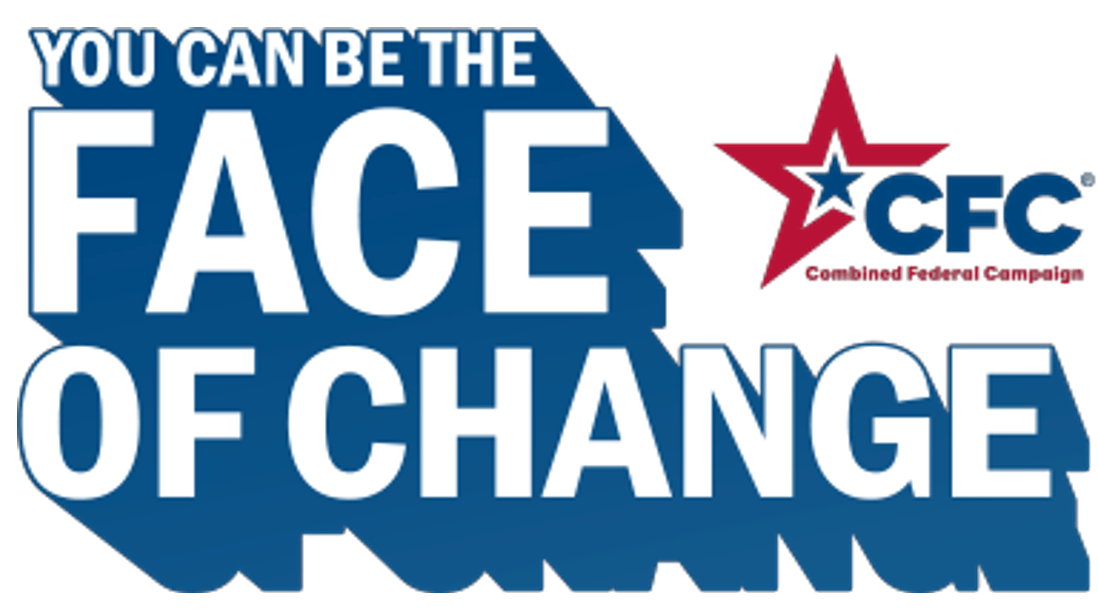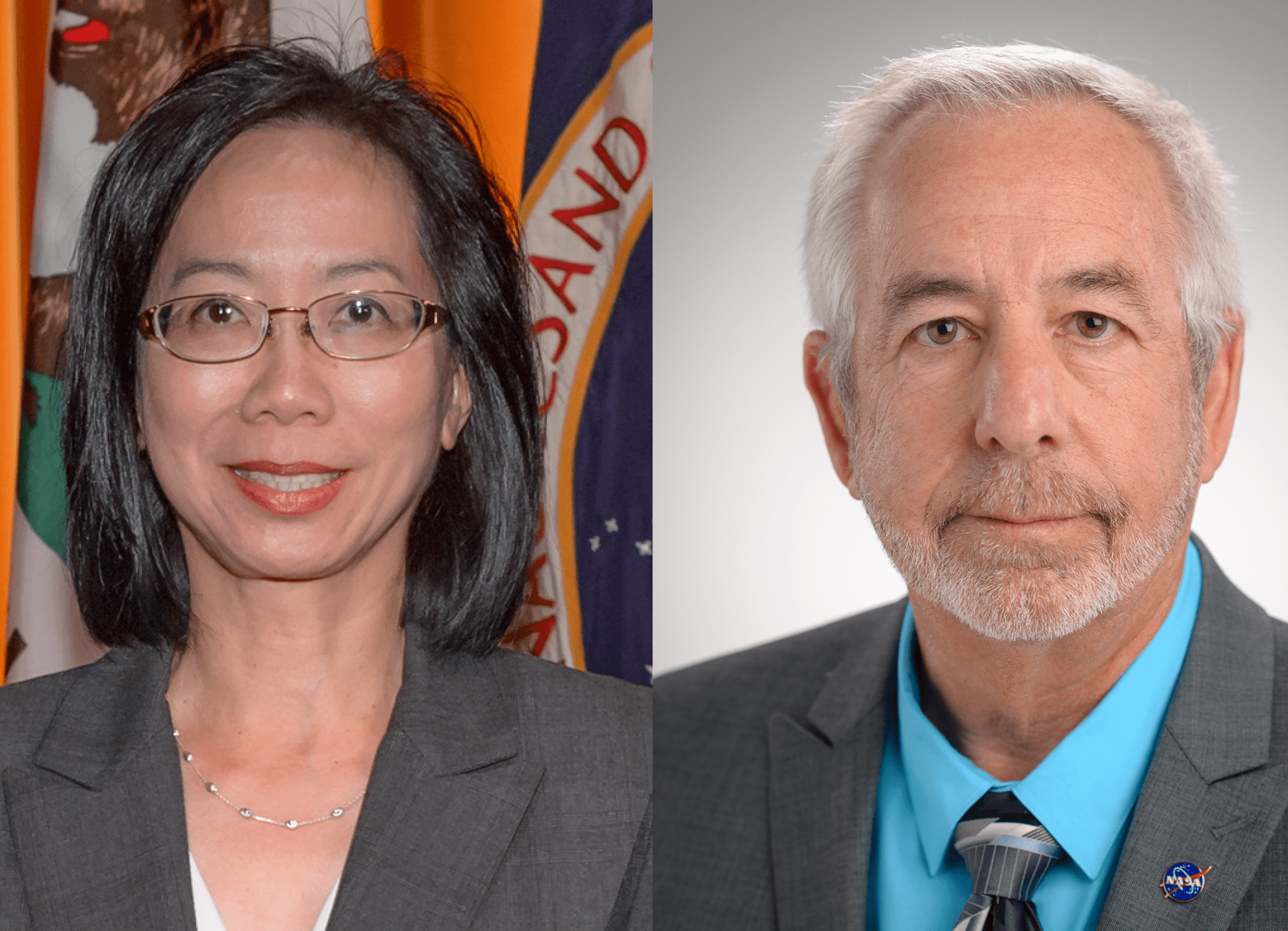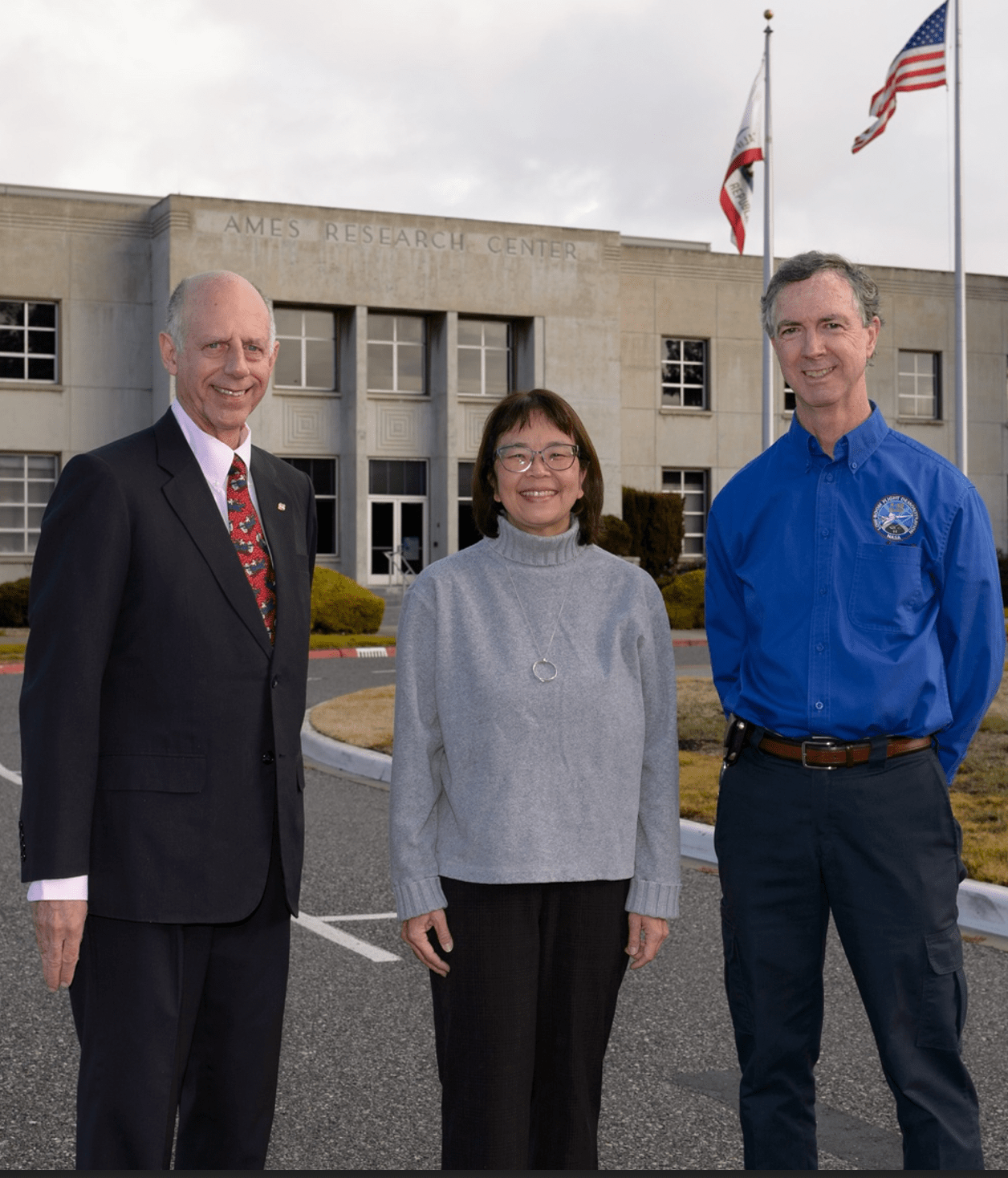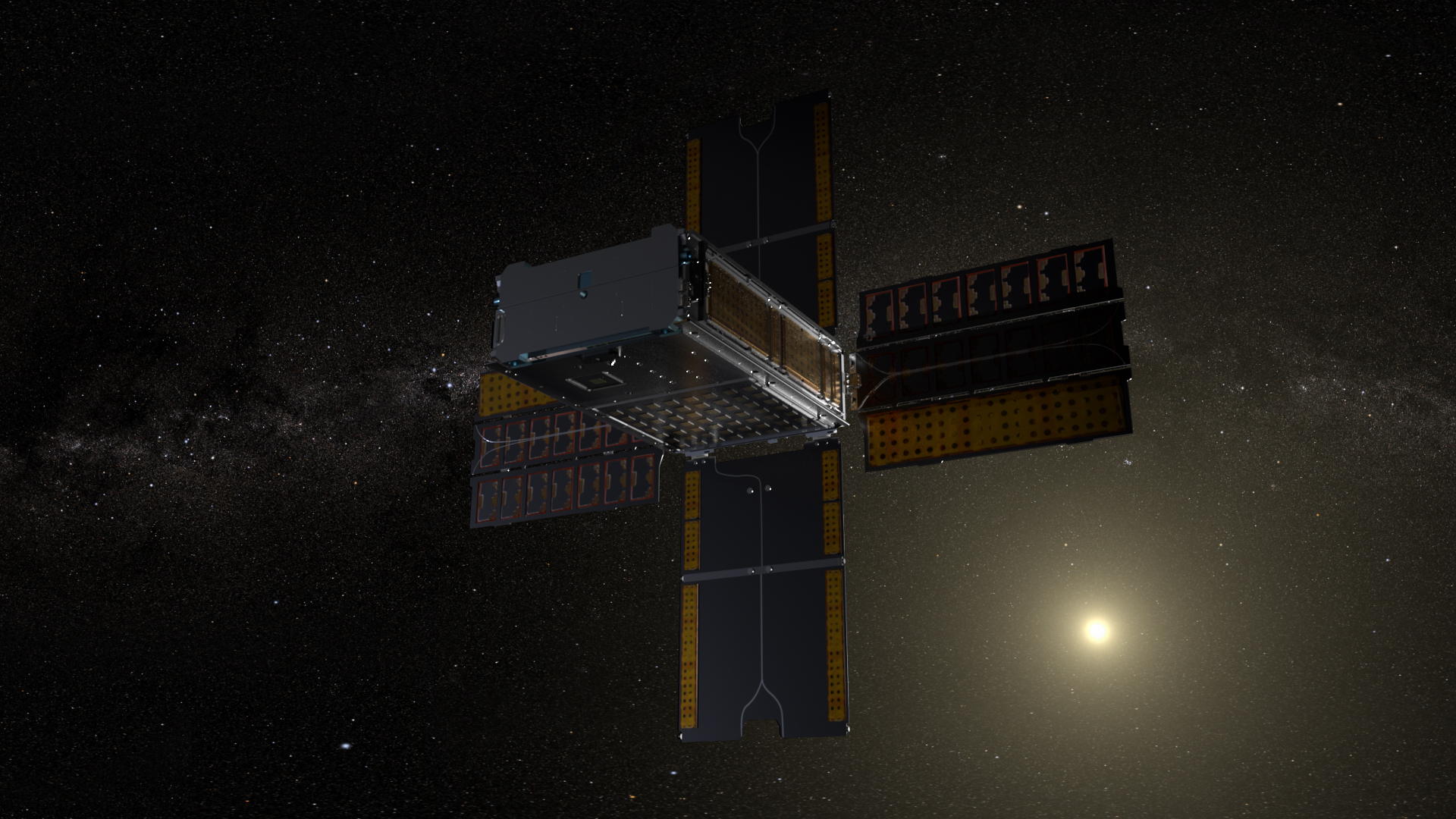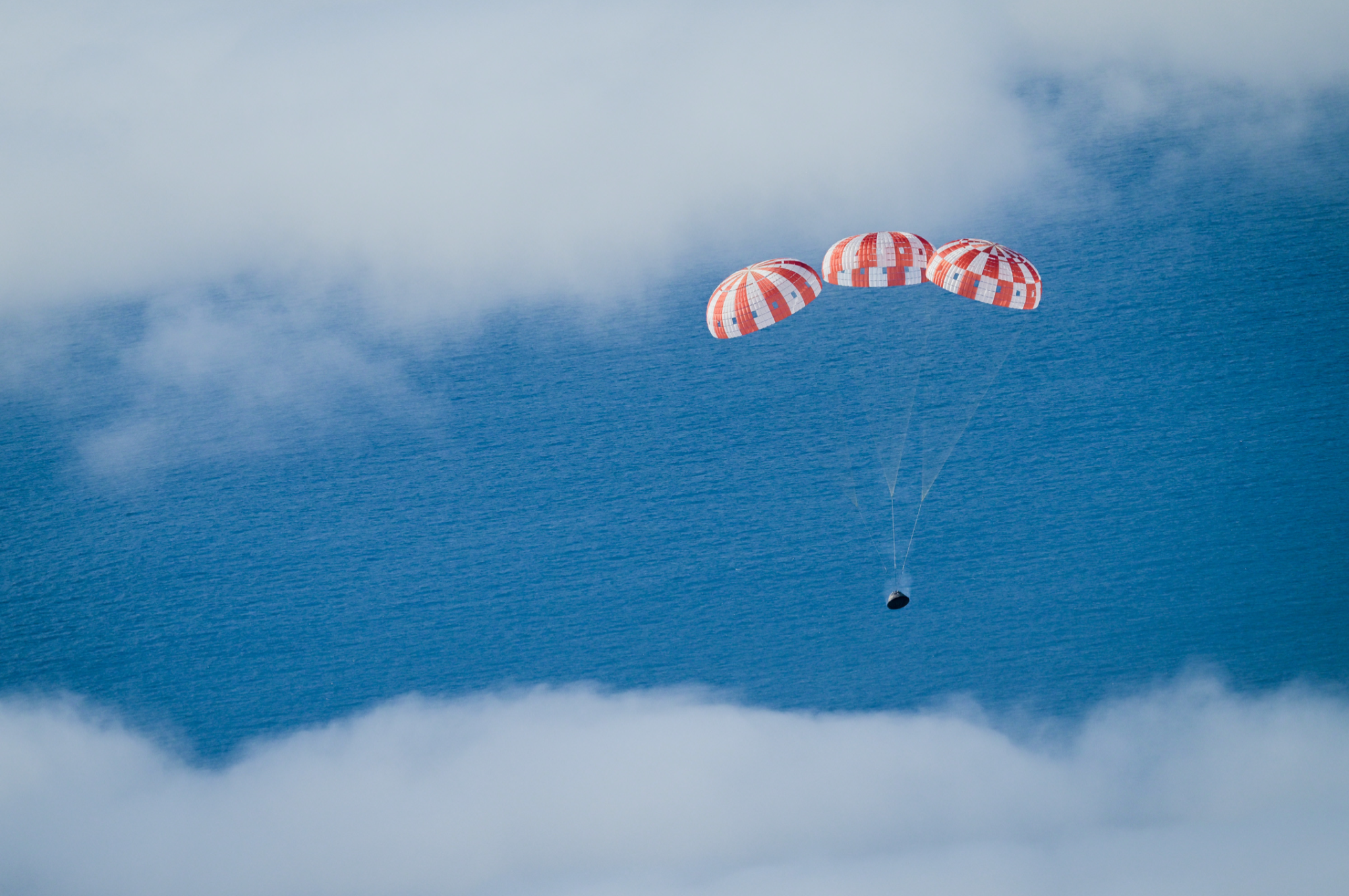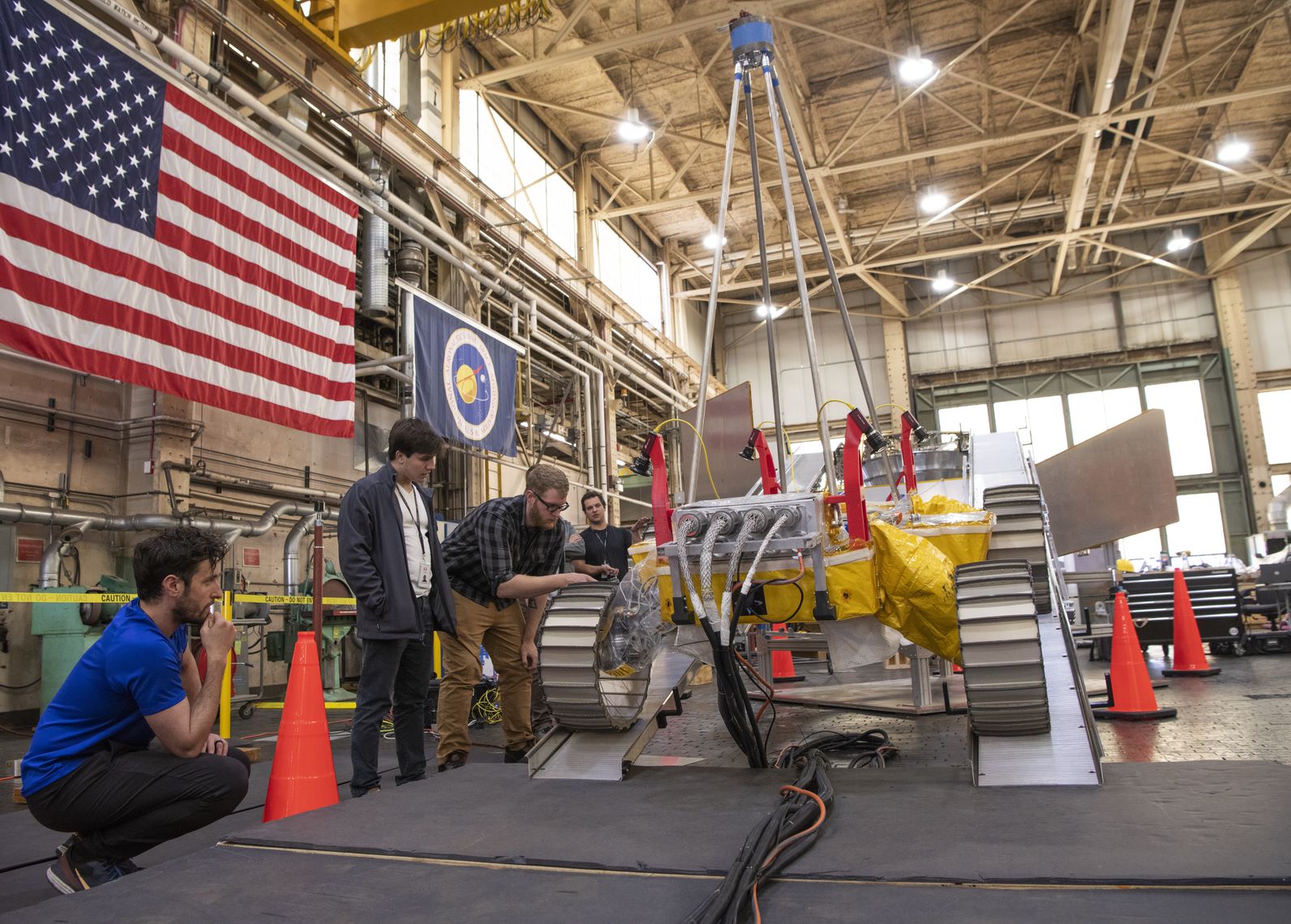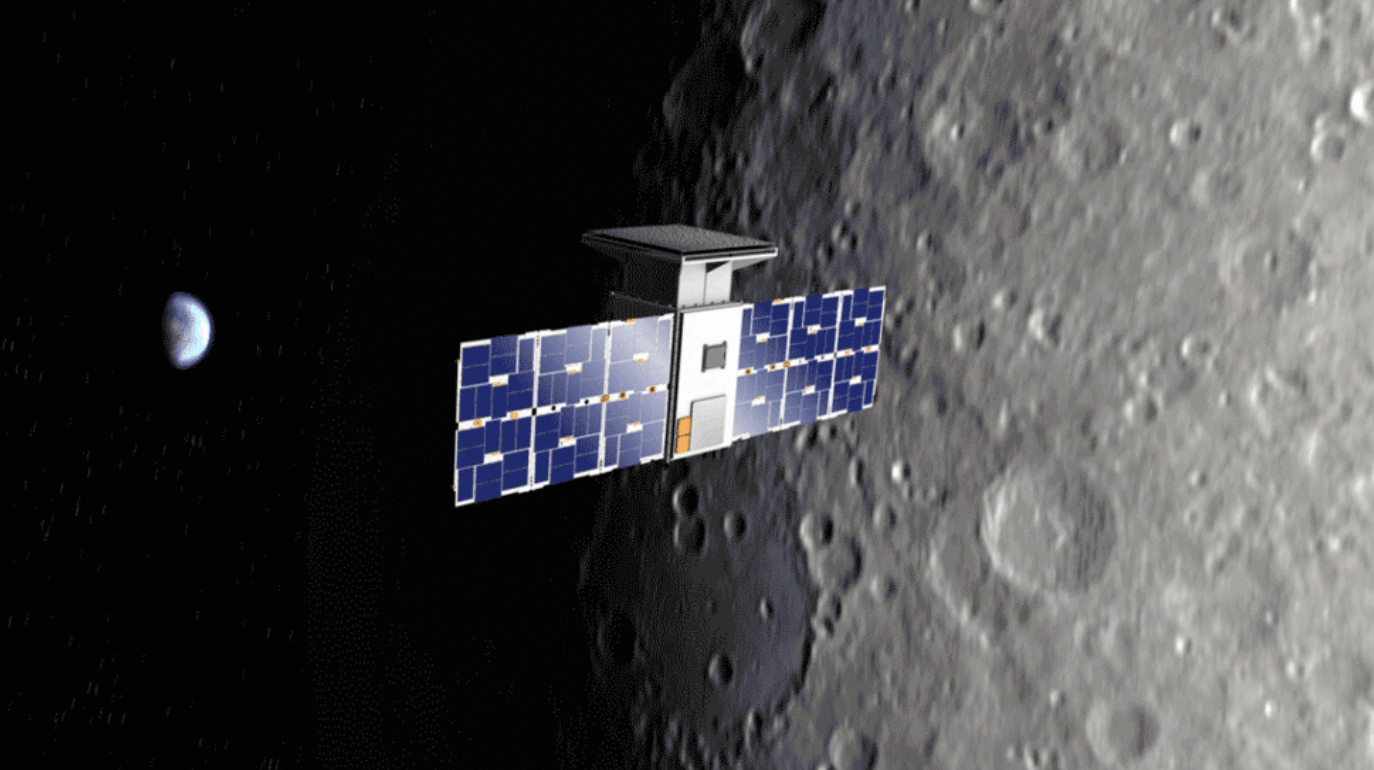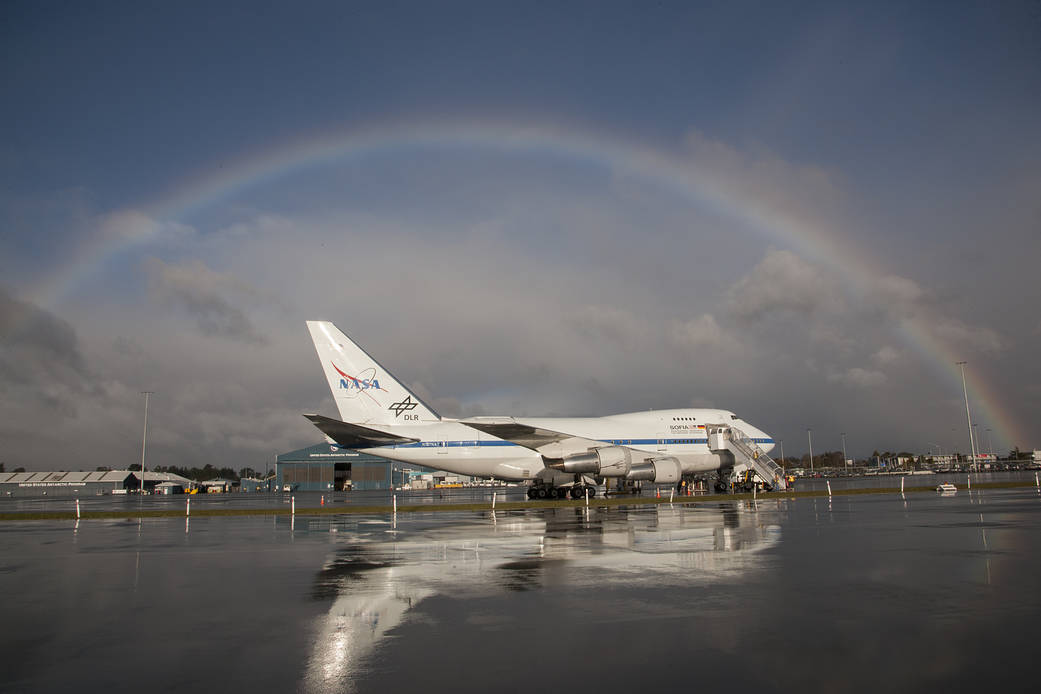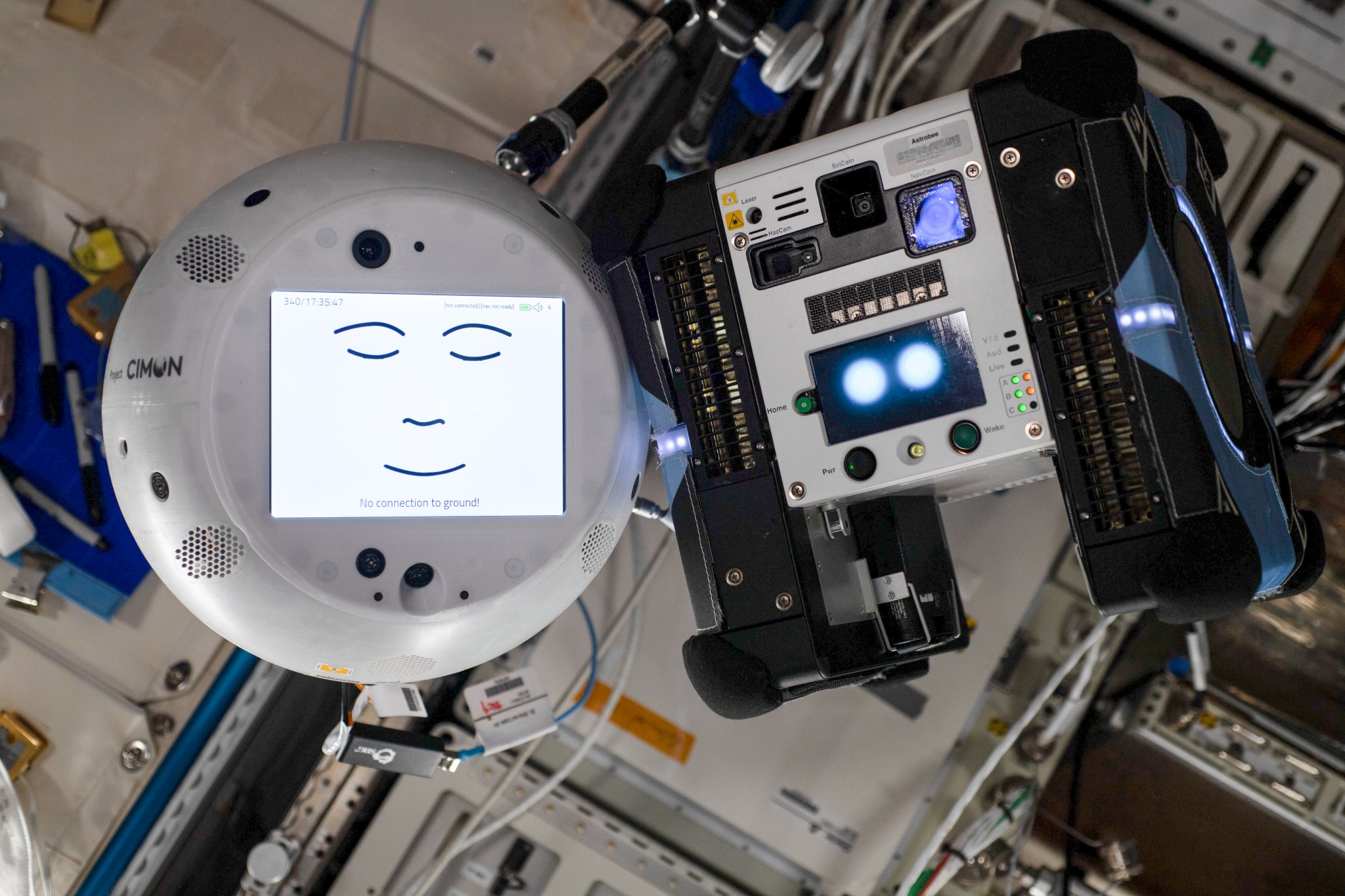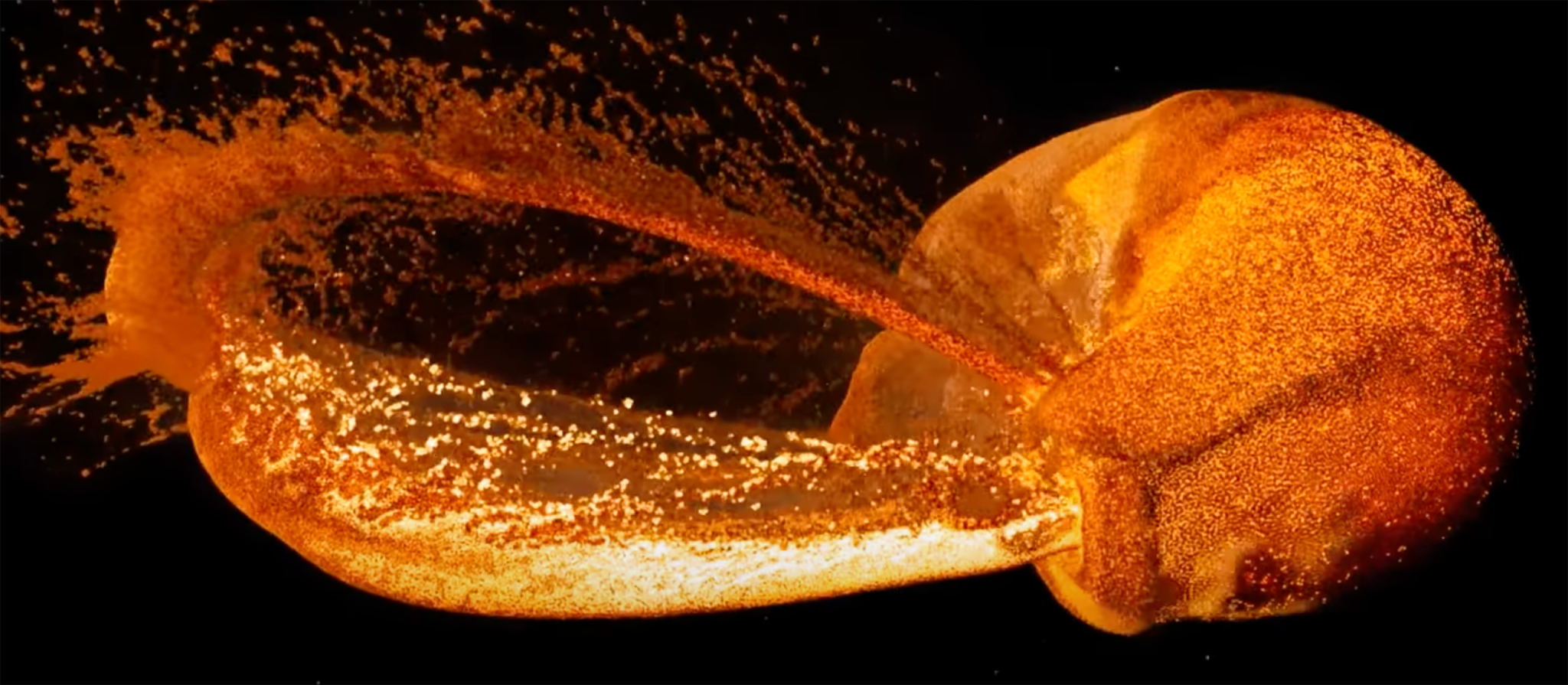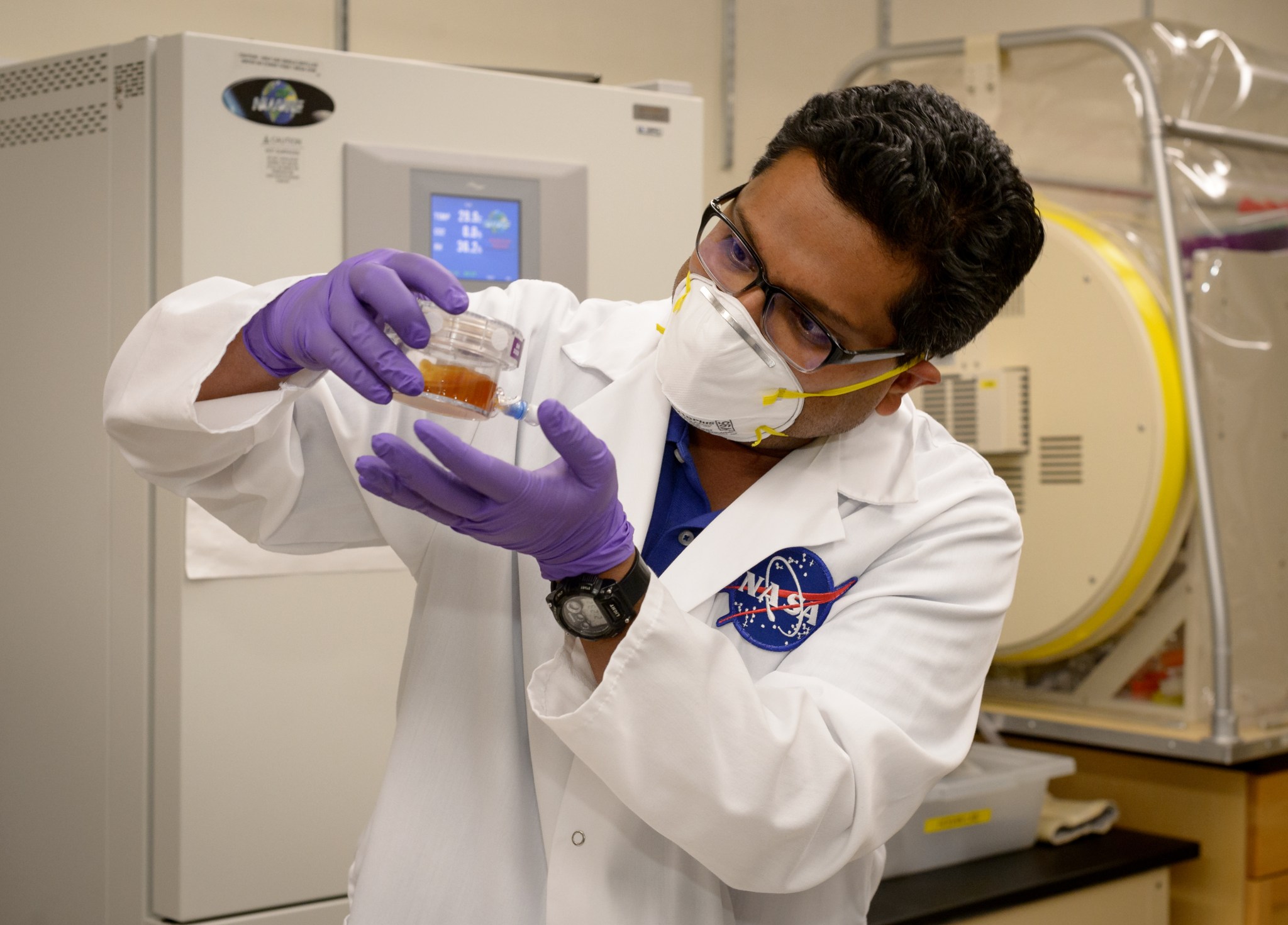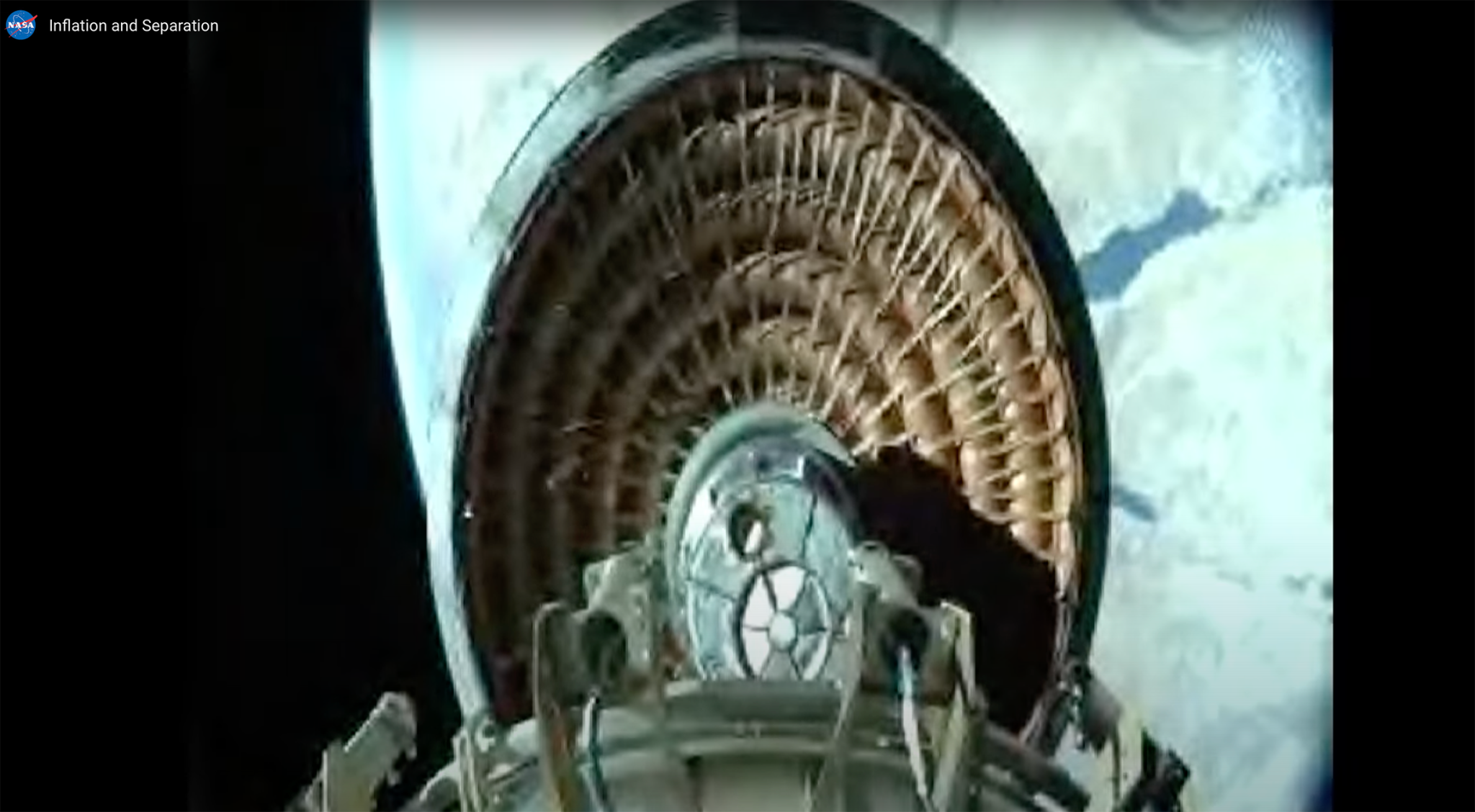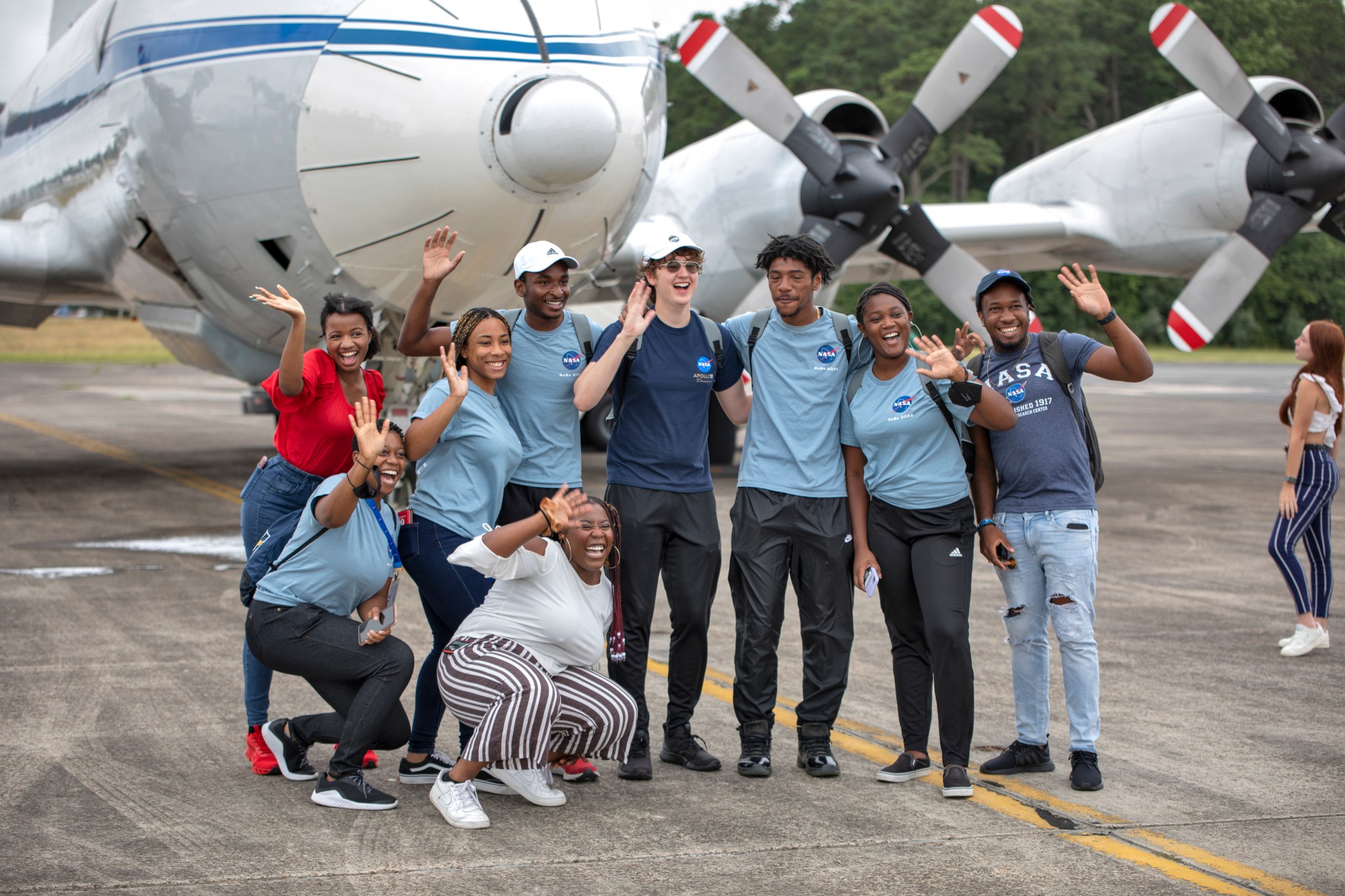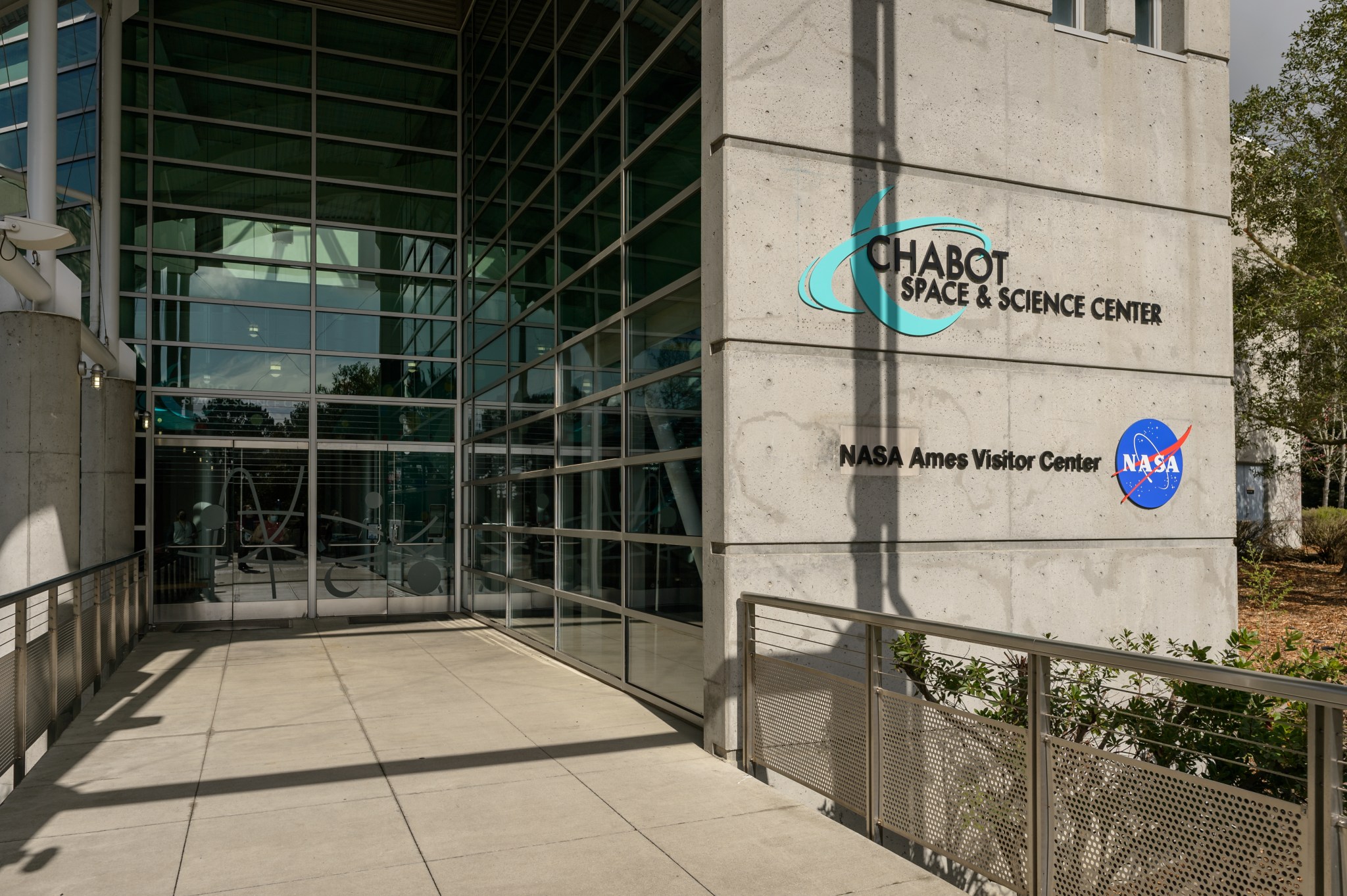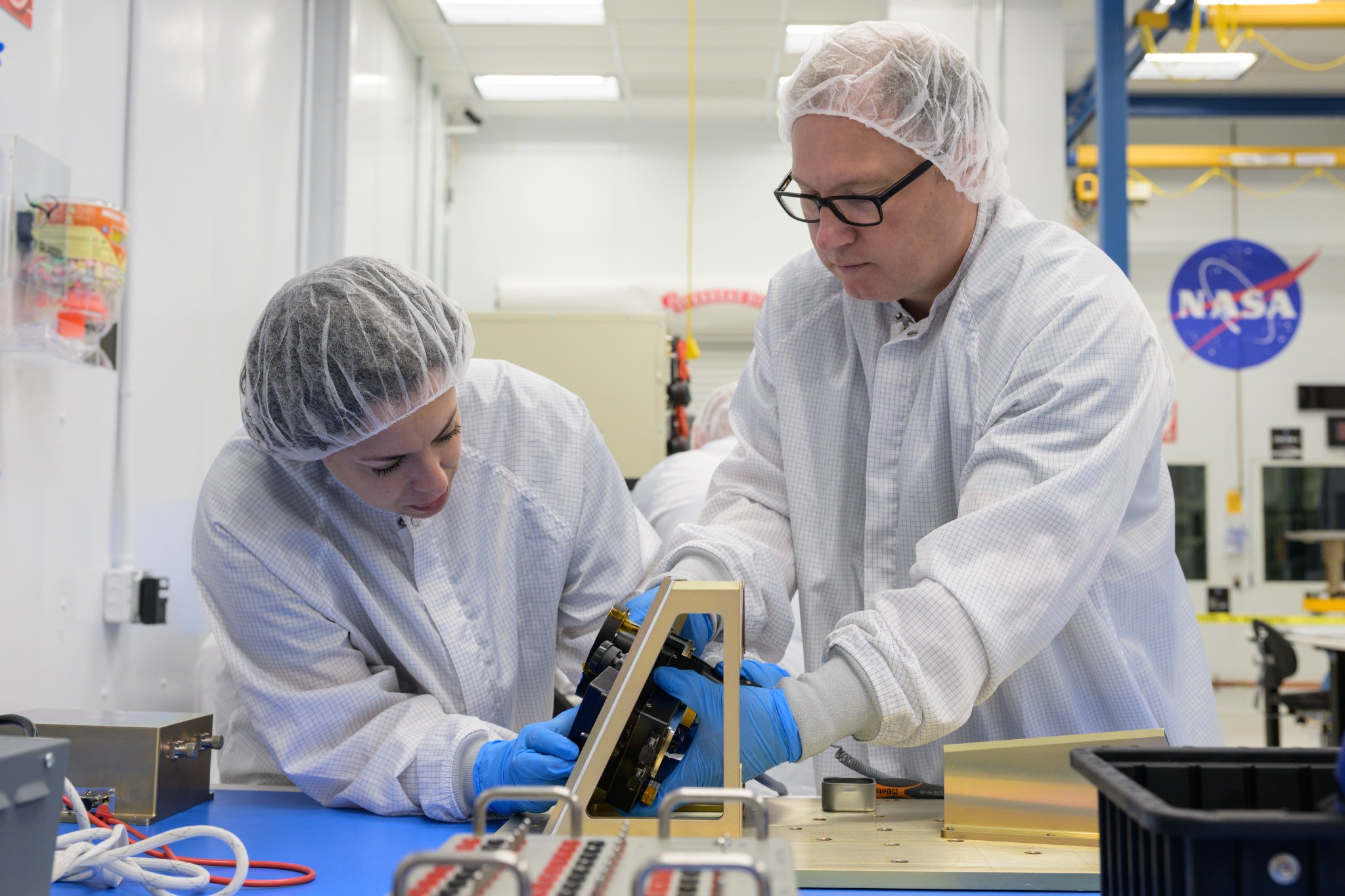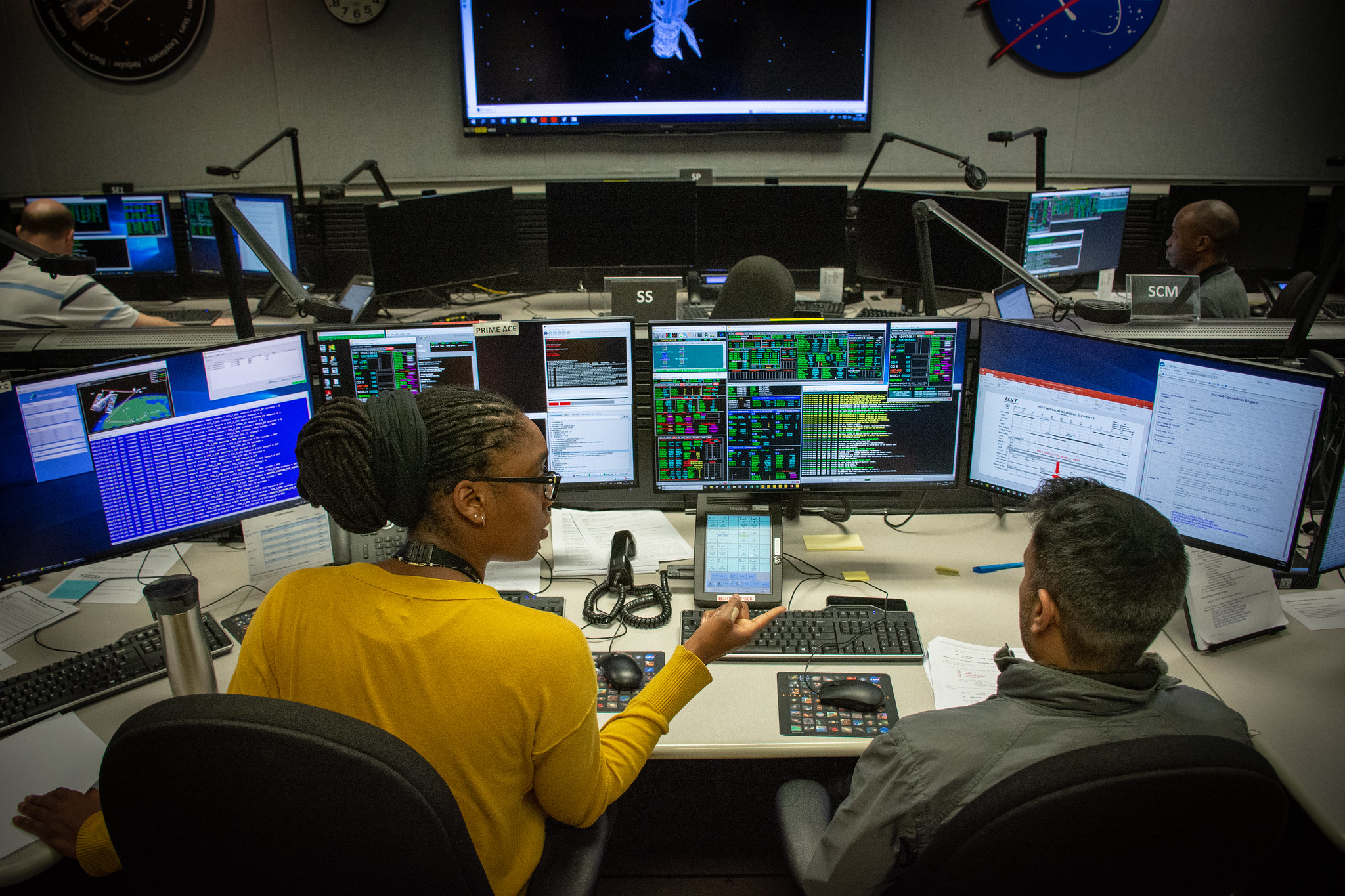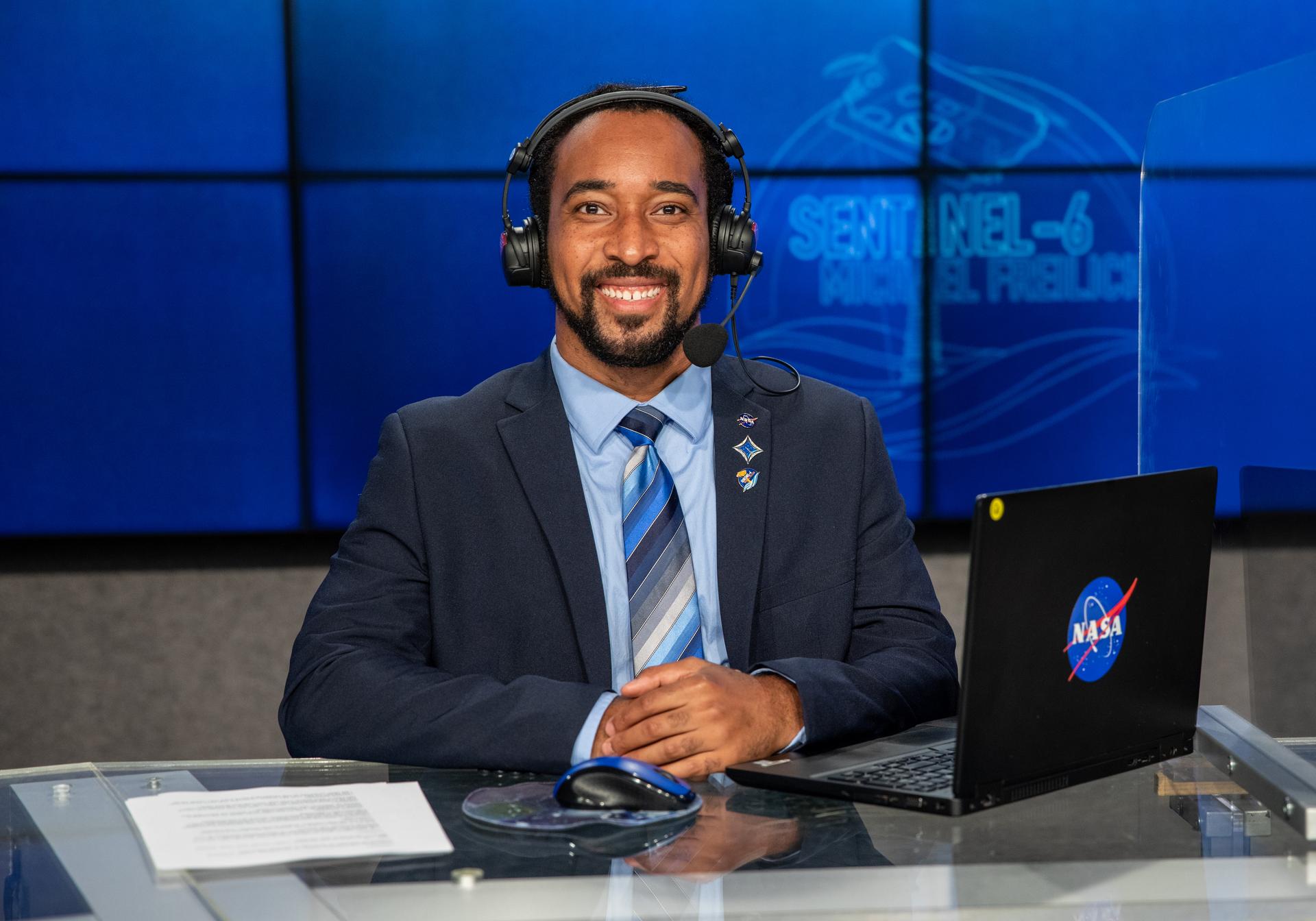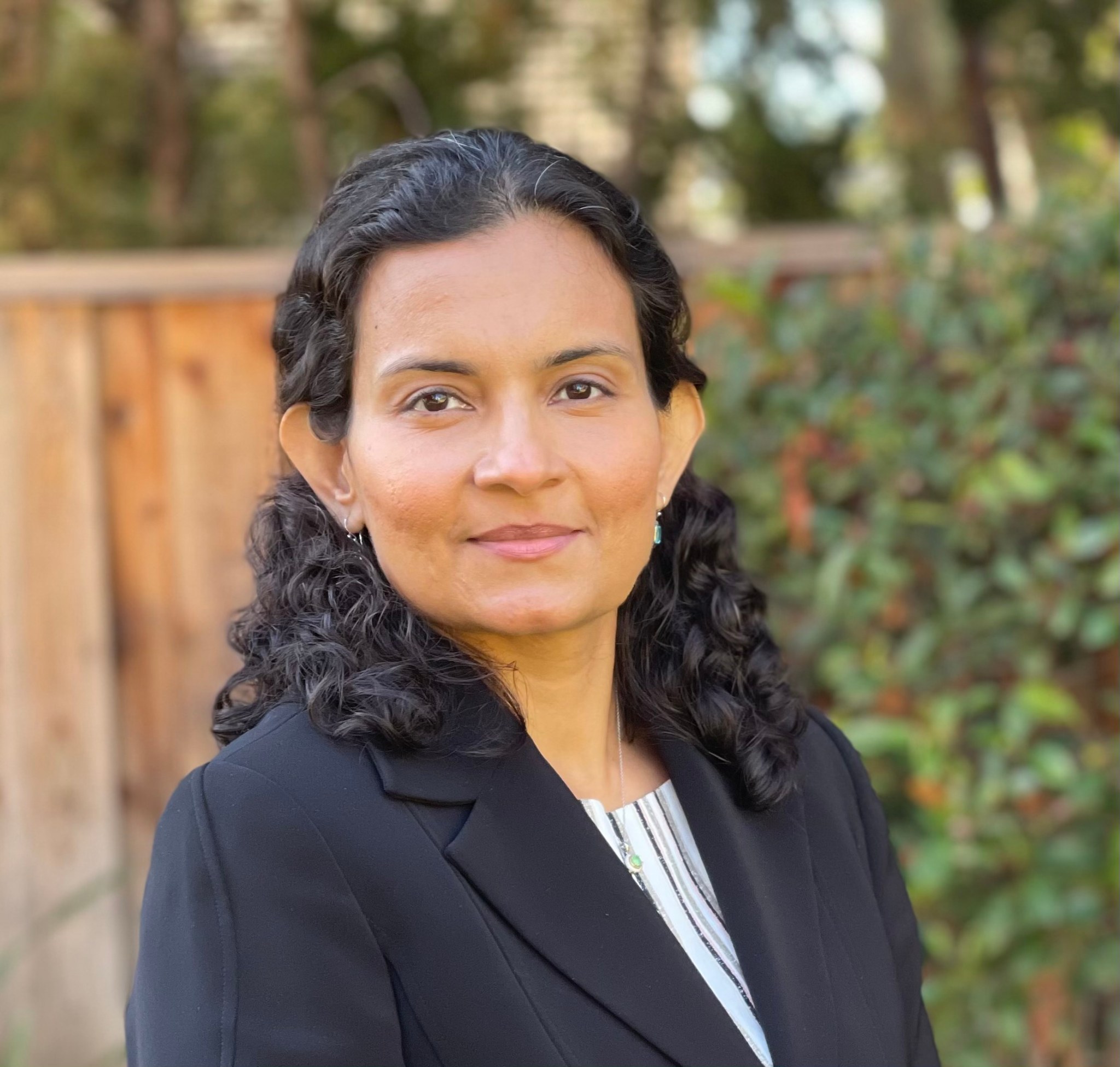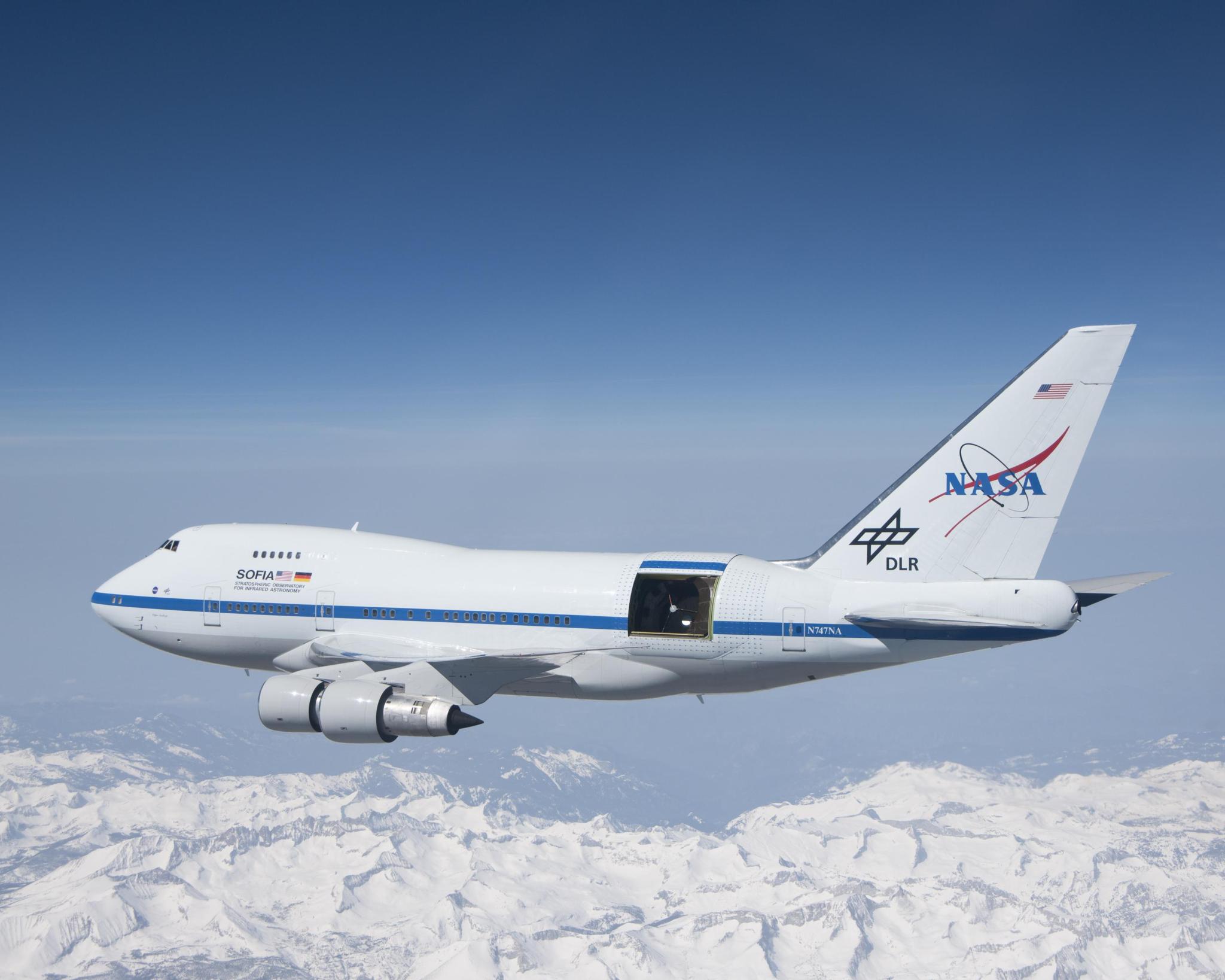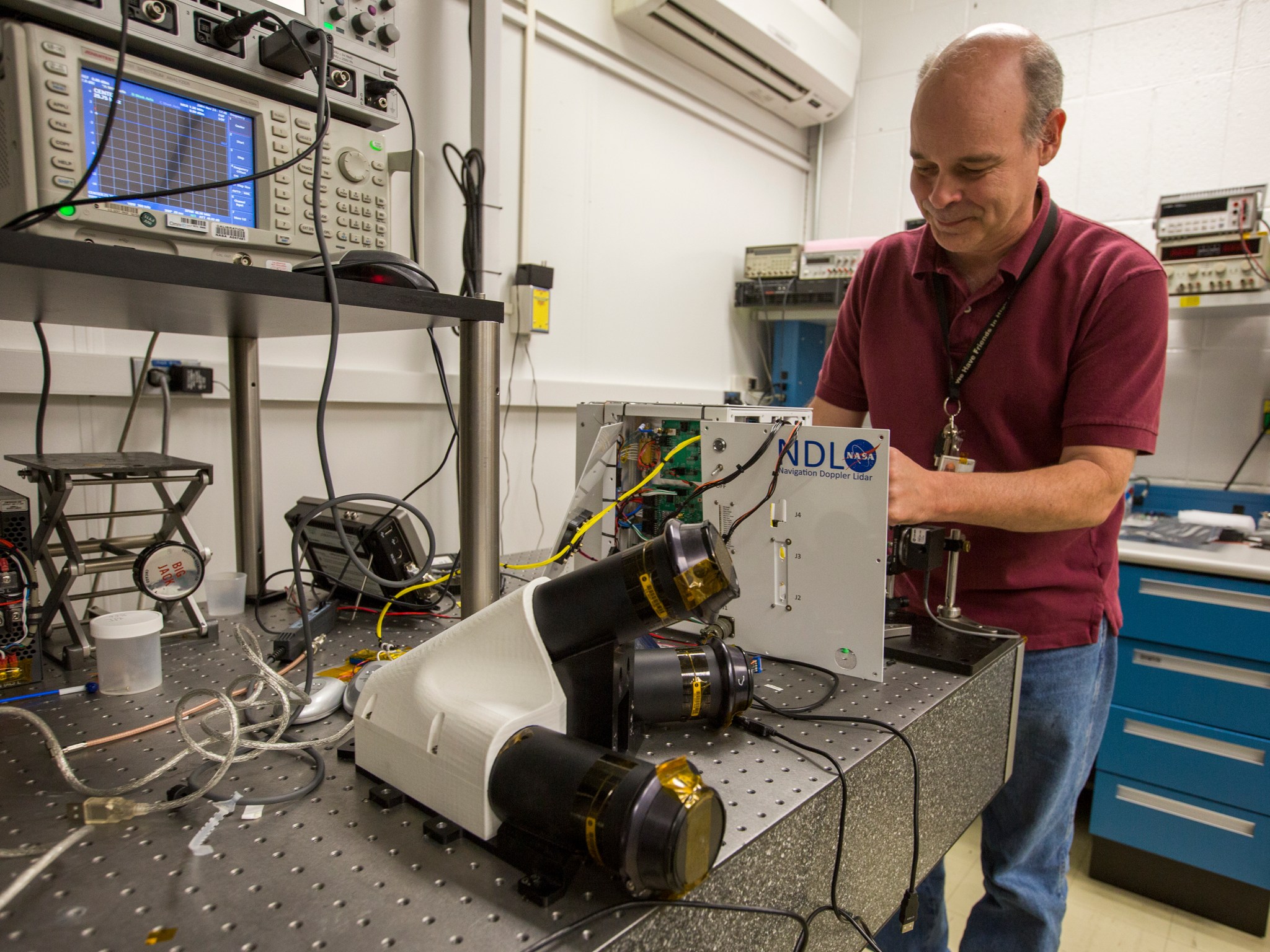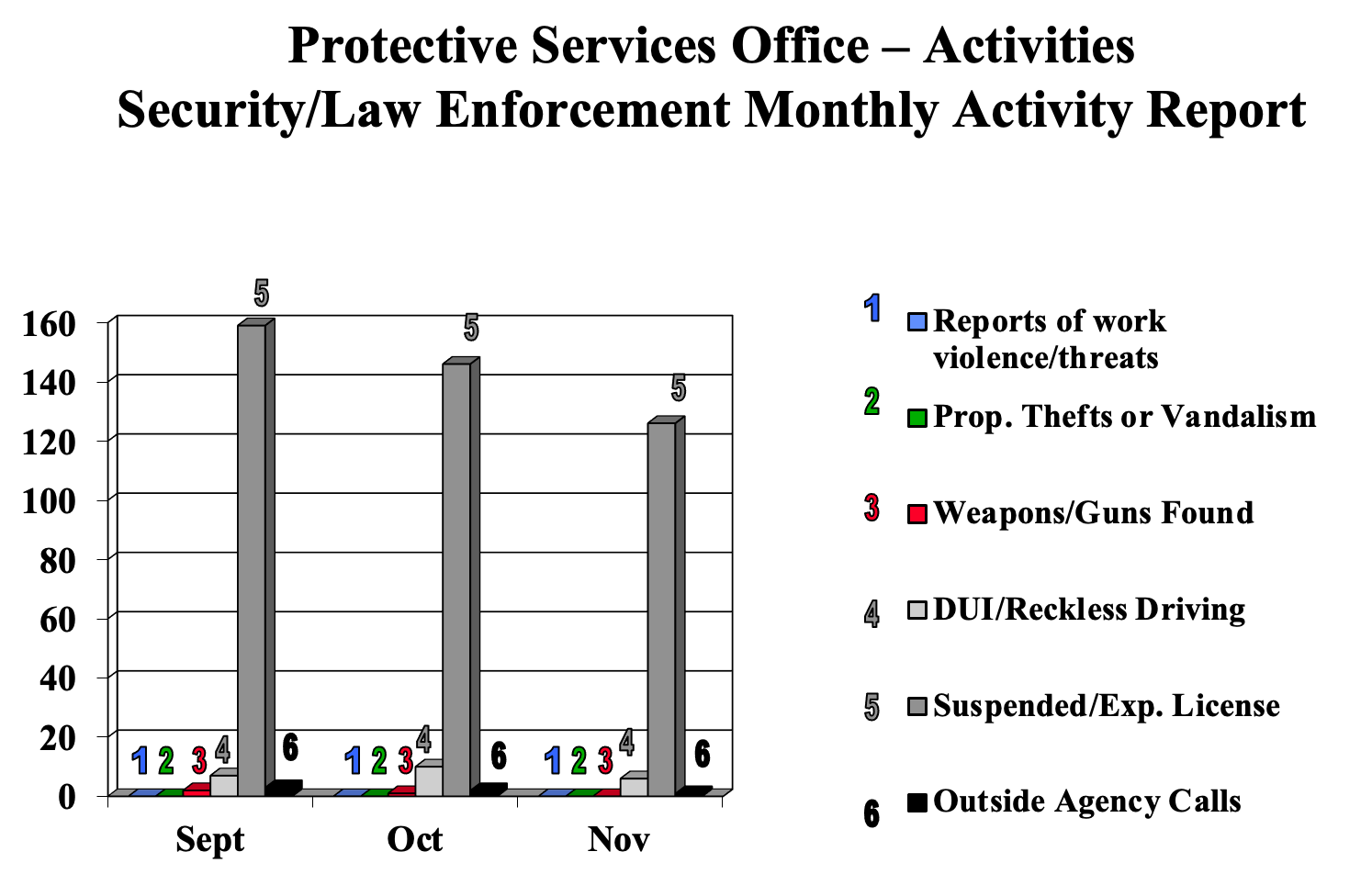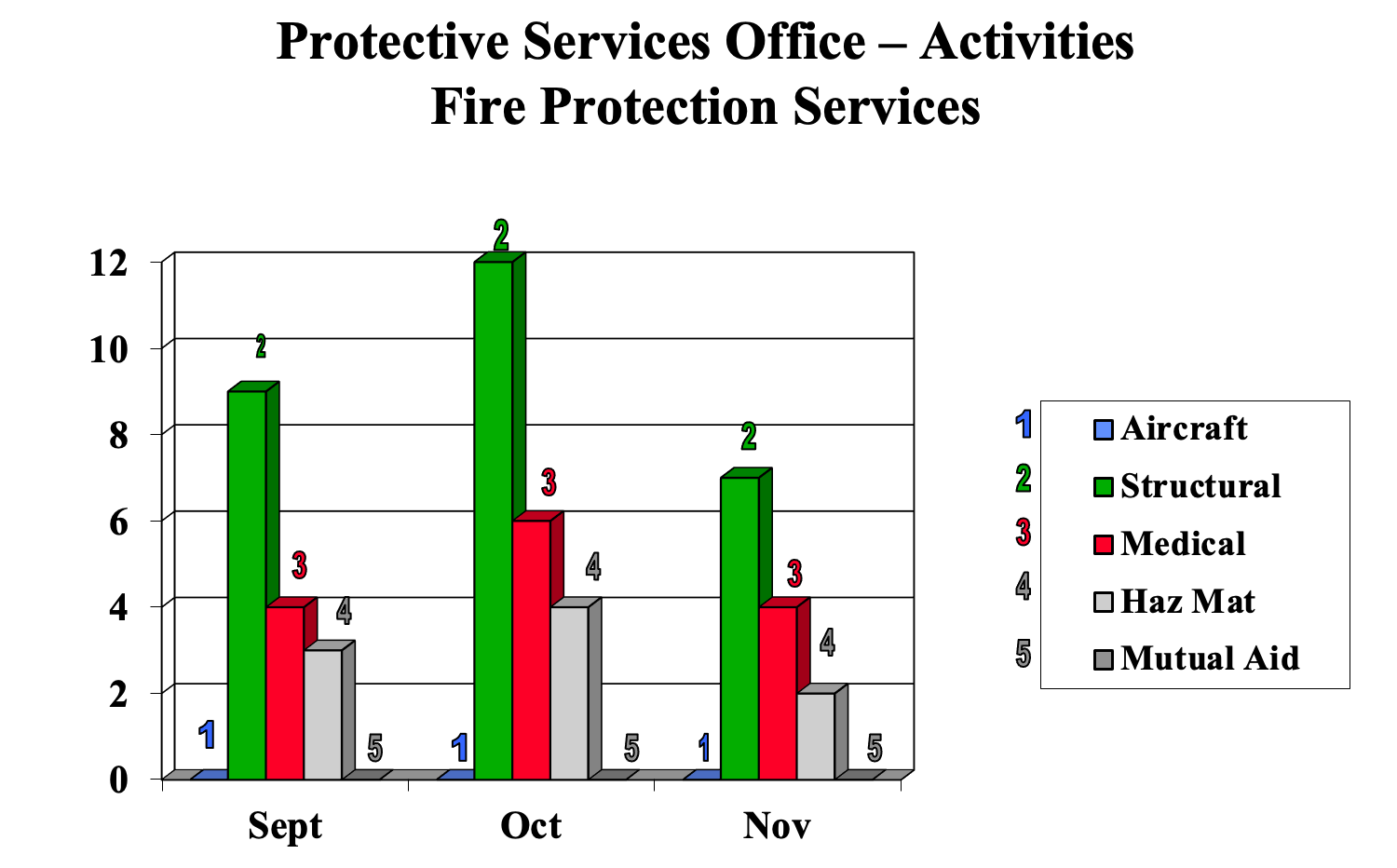Orion’s Successful Splashdown Paves the Way for Artemis’ Future
by Frank Tavares
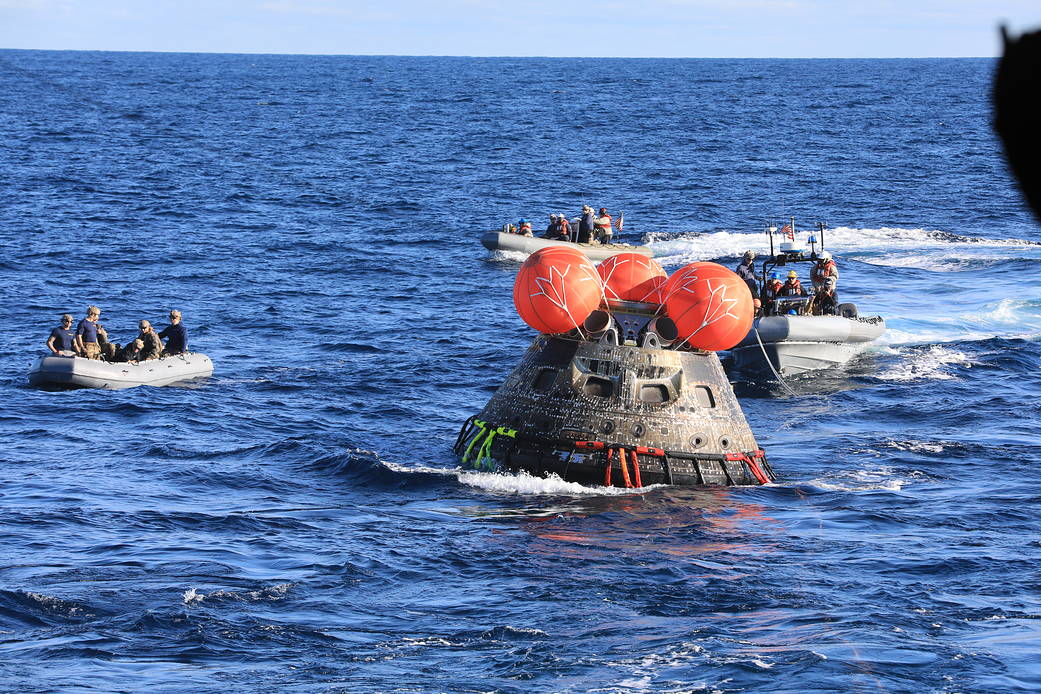
On Sunday, Dec. 11, the Orion spacecraft made its fiery descent through our atmosphere and returned to Earth, splashing down in the Pacific Ocean. Orion’s successful return marks a major milestone and achieves a core objective for the Artemis I mission: a flight test of the Orion heat shield.
NASA’s Ames Research Center in California’s Silicon Valley has been instrumental in the development and testing of Orion’s heat shield, which uses a modified version of the Avcoat material from the Apollo program.
During its return, Orion’s heat shield helped the spacecraft endure temperatures of nearly 5,000 degrees F and 25,000 mph. After splashdown, NASA and the U.S. Navy recovered the spacecraft and brought it back to land. Now that Orion has safely returned to Earth, as early as May 2023, researchers at Ames will study samples of the heat shield material to analyze how well the spacecraft and its thermal protection systems fared in the re-entry environment. That will pave the way for NASA to certify the spacecraft for missions with crew beginning with Artemis II, scheduled to launch in 2024.
The 2022 Combined Federal Campaign (CFC) is Underway!
The CFC theme this year is, “You can be the face of change.”
CFC donations affect the lives of those less fortunate, supporting organizations that benefit your local community as well as international efforts to alleviate hunger, fight diseases, increase literacy, protect animals and the environment – just a few of the causes that benefit from your time or money.
If you have not already donated, the campaign runs through Jan. 14, 2023. Ames Research Center has frequently led the Northern California region in supporting charitable causes – thank you for your generosity! We have a goal of raising $180,000 and are currently at about $36,000 as of early December.
CFC enables civil servants to donate throughout the year via payroll deduction. Anyone else on the center is welcome to make a one-time gift.
Information on how to sign up and donate can be found at cfc.arc.nasa.gov, including contact information for your organization’s keyworkers, who can provide more details on how to participate, including tips on using the searchable database.
A virtual charity fair is available on the website, that has short videos of a selection of worthy causes.
Ames has many team members and keyworkers who help make the campaign a success. The 2022 Ames CFC chief coordinator is Ed Harmon (above photo right) and our deputy chief coordinator is Susie Go (above photo left) and Don Durston is the long-time Ames CFC advisor.
We would like to take this opportunity to thank Phil Fluegemann upon the occasion of his retirement from NASA, after 33 years of dedicated service! Phil represented Ames in the CFC’s Local Federal Coordinating Committee (LFCC) for many years. Kathy Lee will replace Phil on the LFCC. The LFCC consists of representatives from many civilian and military agencies around the Bay Area, and they set the guidelines for and oversee the campaigns at the various agencies. Pictured below, left to right, are Phil Fluegemann, Kathy Lee, and Don Durston.
Did you know?
• Before CFC, fundraising in the federal workplace was not well-organized and was ineffective. Employees were at risk of being pressured to donate by their supervisors, yet most employees donated very little to charitable causes when they were solicited at the workplace.
• During the Eisenhower Administration, in 1956, a program was created to manage and systematize fundraising under three separate campaigns during the year, each focusing on a different type of charity (local charities, health and international service, and the American Red Cross).
• In 1961, under the Kennedy Administration, formal authority was granted to allow fundraising in the federal workplace and the Civil Service Commission was tasked to develop the guidelines.
• In 1964, during the Johnson Administration, a pilot of CFC was conducted and combined the three different campaigns into a once-a-year campaign. This practice saw a dramatic increase in donations.
• Payroll deduction was finally introduced in 1971, during the Nixon Administration, and CFC became the uniform fundraising method for the federal service.
https://www.opm.gov/combined-federal-campaign/
First Deep Space Biology Experiment Begins, Follow Along in Real-Time
by Gianine Figliozzi
NASA’s BioSentinel has carried living organisms farther from Earth than ever before – more than one million miles. Aboard the shoebox-sized CubeSat are microorganisms, in the form of yeast – the very same yeast that makes bread rise and beer brew. On Dec. 5, BioSentinel was 655,730 miles from Earth when the BioSentinel team at NASA’s Ames Research Center in California’s Silicon Valley sent commands to the spacecraft to kick off the initial experiment for the first long-duration biology study in deep space. Scientists are now able to see how living organisms respond to deep space radiation.
Artemis missions at the Moon will prepare humans to travel on increasingly farther and longer-duration missions to destinations like Mars. Because yeast cells have similar biological mechanisms to human cells, including DNA damage and repair, studying yeast in space will help us better understand the risks of space radiation to humans and other biological organisms. BioSentinel’s science results will fill critical gaps in knowledge about the health risks in deep space posed by space radiation.
BioSentinel – which launched aboard Artemis I – is orbiting the Sun, positioned beyond Earth’s protective magnetic field. There, the CubeSat will run a series of experiments over the next five to six months.
NASA invites the public to virtually ride along with BioSentinel’s deep space journey using NASA’s “Eyes on the Solar System” visualization tool, a digital model of the solar system. This real-time simulated view of our solar system runs on real data. The positions of the planets, moons, and spacecraft – including BioSentinel – are shown where they are right now.
You can adjust the level of illumination on the spacecraft by clicking on the show/hide settings button in the bottom right of the screen. Once opened, you can toggle between flood, shadow, and natural lighting. Additionally, you can use time controls – at the bottom of the screen – to fast-forward or rewind time in the simulated view, to preview BioSentinel’s future trajectory or see a recap of its prior path.
NASA’s Ames Research Center leads the science, hardware design and development of the BioSentinel mission. Partners include NASA’s Johnson Space Center in Houston and NASA’s Jet Propulsion Laboratory in Southern California. BioSentinel is funded by the Artemis Campaign Development Division within NASA’s Exploration Systems Development Mission Directorate at NASA headquarters in Washington.
2022 in Review: Highlights from NASA in Silicon Valley
by Abigail Tabor
With 2023 on the horizon, join us as we look back at the highlights of 2022 at NASA’s Ames Research Center in California’s Silicon Valley.
1. We are Artemis.
NASA’s historic flight mission to the Moon, Artemis I, is complete! The first in a series of increasingly complex missions that will enable human exploration to the Moon and Mars, Artemis I is the first integrated flight test of the agency’s deep space exploration systems: the Orion spacecraft, Space Launch System (SLS) rocket, and ground systems. Ames helped pave the path for Artemis I to achieve its mission, including through science missions aboard Artemis I, supporting SLS, and testing Orion’s heat shield.
The SLS rocket carrying the Orion spacecraft launched the Artemis I flight test on Nov. 16, from NASA’s Kennedy Space Center in Florida. Artemis I also carried NASA’s BioSentinel – a shoebox-sized CubeSat managed and built at Ames. The CubeSat flew by the Moon on Nov. 22, and is orbiting around the Sun, where it’s conducting the first long-duration biology experiment in deep space.
Orion reached a maximum distance of nearly 270,000 miles from Earth before beginning its journey back toward Earth. Orion completed its mission and made history on Dec. 11, when it returned to Earth and splashed down in the Pacific Ocean, west of Baja California.
2. Peering into the cosmos.

It’s been a landmark year for cosmic science, with the James Webb Space Telescope successfully starting its scientific operations a million miles away from Earth. Already, this next-generation instrument has uncovered never-before-seen features of well-known parts of the universe, like the Orion Nebula (above) and the Pillars of Creation.
Ames researchers are using data from Webb to study exoplanets, star evolution, and more. With its sensitive infrared tools, Webb is a game-changer for the study of polycyclic aromatic hydrocarbons (PAHs), one of the most abundant types of molecules in space. PAH researchers hope to shed some light on major stellar processes, like the ways stars and galaxies form and evolve.
Webb has already notched some significant firsts in exoplanet research. In August, scientists announced they had detected the first clear evidence for carbon dioxide in the atmosphere of a planet outside our solar system.
3. Prepping for a Moon walk.
NASA’s historic flight mission to the Moon, Artemis I, is complete! The first in a series of increasingly complex missions that will enable human exploration to the Moon and Mars, Artemis I is the first integrated flight test of the agency’s deep space exploration systems: the Orion spacecraft, Space Launch System (SLS) rocket, and ground systems. Ames helped pave the path for Artemis I to achieve its mission, including through science missions aboard Artemis I, supporting SLS, and testing Orion’s heat shield.
The SLS rocket carrying the Orion spacecraft launched the Artemis I flight test on Nov. 16, from NASA’s Kennedy Space Center in Florida. Artemis I also carried NASA’s BioSentinel – a shoebox-sized CubeSat managed and built at Ames. The CubeSat flew by the Moon on Nov. 22, and is orbiting around the Sun, where it’s conducting the first long-duration biology experiment in deep space.
Orion reached a maximum distance of nearly 270,000 miles from Earth before beginning its journey back toward Earth. Orion completed its mission and made history on Dec. 11, when it returned to Earth and splashed down in the Pacific Ocean, west of Baja California.
4. The future of flight.
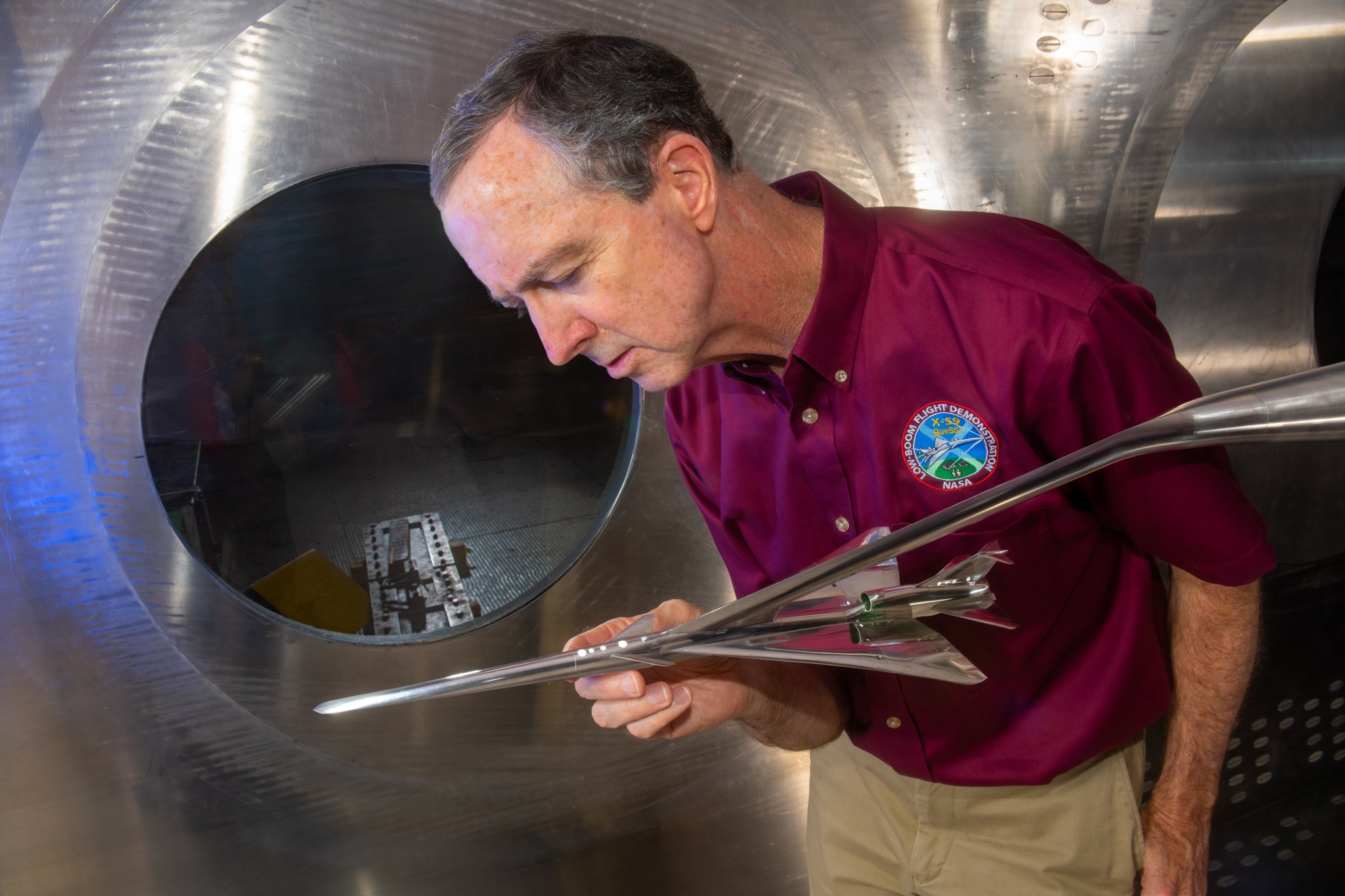
NASA’s work in air traffic management, wind tunnel testing, and computational simulations led to the savings of millions of gallons of jet fuel and brought the agency one step closer to the first flight of NASA’s X-59 Quiet SuperSonic Technology.
Engineers working to finalize X-59’s design used an Ames-developed program to simulate flight characteristics and noise levels. Ames also led design and fabrication of a scale model of the X-59 for sonic boom wind tunnel testing.
The Airspace Technology Demonstration-2 (ATD-2) project won this year’s Maverick Award from the World ATM Congress for its four-year demonstration of airport traffic prediction software at the Charlotte-Douglas International Airport in North Carolina. The IADS system demonstration saved more than 1.1 million gallons of jet fuel and $1.4 million in flight crew costs. A similar tool was implemented at the Dallas-Fort Worth International Airport. The air traffic prediction tool has prevented the release of 76,000 pounds of carbon dioxide into the atmosphere since implementation.
NASA also tested a model slice of the Transonic Truss-Braced Wing (TTBW) aircraft in the Unitary Plan Wind Tunnel at Ames. The TTBW passenger aircraft – a collaboration between NASA and Boeing – features an ultra-thin and lightweight design that could use significantly less fuel than current passenger aircraft.
5. Fly me to the Moon.
NASA’s CAPSTONE CubeSat made great strides this year, forging a new path for future Artemis missions. CAPSTONE – short for Cislunar Autonomous Positioning System Technology Operations and Navigation Experiment – is a technology demonstration, designed to prove the reliability of new capabilities so that they can be used in future missions.
The CubeSat launched on Jun. 28. Over the course of more than four months, it overcame challenges to traverse a long but fuel-efficient trajectory to the Moon. CAPSTONE is the first CubeSat to operate at the Moon, and the first spacecraft to fly in an elongated orbit called a near rectilinear halo orbit. This orbit is the same planned for NASA’s Gateway, a Moon-orbiting space station that will support NASA’s Artemis missions.
6. Celebrating SOFIA.
The Stratospheric Observatory for Infrared Astronomy (SOFIA) was a mission of discovery, revealing unseen – and sometimes unseeable – parts of our universe. The observatory, which was managed at Ames, was a highly modified airplane carrying a 100-inch telescope. After SOFIA was retired in September, the aircraft made a final visit to Ames, where team members, colleagues, and elected officials were able to say farewell.
But even as we take a look back at SOFIA’s scientific accomplishments and some of the feats of engineering that let it fly, the mission’s science goes on! In results published recently, researchers used SOFIA to look for phosphine gas, a potential indicator of life, in the atmosphere of Venus. Contrary to another study that garnered widespread interest in 2020, their results show no phosphine on the planet, allowing SOFIA to contribute to the body of evidence on this topic.
7. Bots in space!
From AI space companions to self-assembling “builder robots,” humans and machines are working together to advance space exploration.
In April, the Astrobee free-flying robots celebrated their third anniversary aboard the International Space Station, where they’re learning to support astronaut duties and monitor station health. The Astrobees, managed at Ames, marked many milestones in 2022: they mapped new modules of the space station, captured their first 360-degree image, and operated independently on different projects at the same time alongside their human colleagues in space.
NASA’s future space robots need to operate with humans, but they’ll also need to work together without human intervention. The HelioSwarm mission, which the agency selected to move forward this year, will send nine spacecraft to collect never-before-seen data about our Sun’s magnetic field.
Ames researchers have also moved one step closer to self-building space structures with the ground demonstration of the Automated Reconfigurable Mission Adaptive Digital Assembly Systems (ARMADAS)project. NASA’s plans to sustainably explore the Moon and Mars will rely on technologies like ARMADAS to autonomously assemble habitats, solar power systems, and communications structures in space, instead of sending large pre-assembled hardware from Earth.
8. Putting the 'super' in supercomputing.
Whether developing new technologies for landing on other planets, improving commercial travel, improving global weather and climate predictions, or studying the formation of planetary bodies, supercomputing is key to the success of NASA missions and science.
The Modular Supercomputing Facility at Ames, which debuted in 2019, was expanded in May 2022 to increase its computational power by 22%. It is now NASA’s most powerful, yet energy-efficient, supercomputer. This facility, and others at the NASA Advanced Supercomputing facility at Ames, continues to support a host of research projects led by scientists across the world.
Using the DiRAC High-Performance Computing Facility, researchers at Ames and Durham University produced a simulation that suggests a different theory about the Moon’s formation – that it may have formed immediately, in a matter of hours, instead of over months or years. The simulations are some of the most detailed of their kind, operating at the highest resolution of any simulation run to study the Moon’s origins.
9. "What's a yeastronaut?"
Studying life was also on Ames scientists’ docket this year. They explored ways microbes can help us, whether by cleaning up pollution in Earth’s soil or producing nutrients on-demand aboard the space station. BioNutrients is a space biology experiment using microorganisms, like yeast and bacteria, to produce things like antioxidants that will be critical for human health in space. BioNutrients-2 launched recently to the space station and will test the power of microbes to make yogurt and more for astronauts!
To help prepare for astronauts’ potential health issues on future long-duration missions to the Moon and Mars, scientists at Ames studied how the extreme conditions of space affect the biology of fruit flies. Their findings suggest that space travel has an impact on the central nervous system, but that artificial gravity provides partial protection against those changes.
An Ames-led investigation, the Lunar Explorer Instrument for space biology Applications (LEIA), was selected in June to make biology research possible on the Moon. The CubeSat-based science suite will deliver yeast to the lunar surface to study how partial gravity and deep space radiation – two of the biggest challenges of the space environment – combine to influence biological processes.
10. Beat the heat!
NASA has its sights set on sending humans to Mars and spacecraft even farther out in our solar system in the coming decades. This year the Low-Earth Orbit Flight Test of an Inflatable Decelerator (LOFTID) mission tested a new heat shield that could enable large-scale missions to Mars, Venus, and Titan, as well as protect spacecraft during the fiery re-entry through Earth’s atmosphere.
LOFTID successfully launched Nov. 10, 2022. Once it deployed from orbit, the heat shield autonomously inflated and re-entered Earth’s atmosphere, splashing down about 500 miles off the coast of Hawaii.
Ames has a long history leading heat shield innovations to protect spacecraft during atmospheric entries. Teams at Ames continue that tradition as they develop two heat shields for the Mars Sample Return mission – one for landing on Mars and one for returning to Earth. Ames also supports heat shield development for the Dragonfly mission to Titan, the biggest of Saturn’s moons.
11. NASA the Next Generation.
Researchers at NASA today know the story of science and exploration doesn’t end with them. Two new programs run by Ames contributed to training tomorrow’s researchers and ensuring they reflect the diversity of the nation.
During the Student Airborne Science Activation (SaSa) summer research program, undergraduate students from minority-serving institutions (MSIs) gained hands-on experience running a scientific research campaign on land, ocean, or atmospheric phenomena. SaSa’s leaders hope to reach students while their perceptions of career opportunities are forming and to provide support and the means to enter their chosen career.
A team of NASA biologists took a different approach by teaching the teachers. During NASA’s space biology bootcamp, educators from historically Black colleges and universities and MSIs received hands-on instruction in analyzing real data from GeneLab – NASA’s unique repository of data from biology experiments conducted in space. GeneLab is managed by Ames and its data is available to all, but you have to know how to use it. The participating educators are already passing that knowledge on to their students.
12. Eyes in the sky.
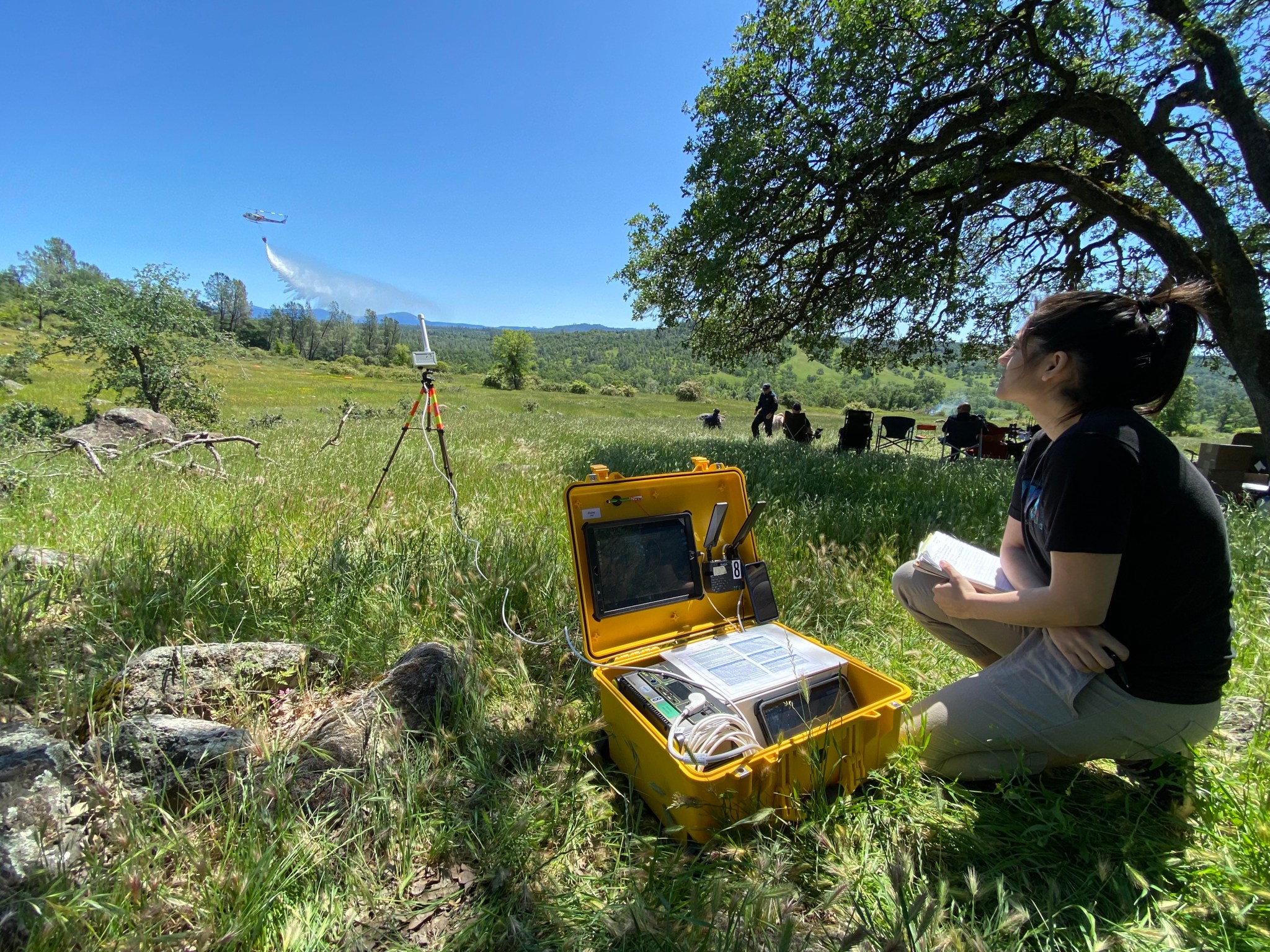
NASA and its partners at the U.S. Geological Survey, U.S. Forest Service, CAL FIRE, and American small businesses are using drones to solve big problems. With flights to Makushin Volcano in Alaska’s Aleutian Islands, a group of federal scientists and industry engineers demonstrated how a drone could successfully fly without its pilot’s eyes on the aircraft. That opens new possibilities for monitoring volcanoes and other hazards worldwide. Sending humans to survey volcanoes up close can be dangerous and costly, but drones are moving us toward a future where remote but hazardous volcanoes are consistently monitored for signs an eruption could be brewing.
Meanwhile, this year, NASA researchers tested their prototype tools to help make firefighters safer once a wildfire erupts. The Scalable Traffic Management for Emergency Response Operations (STEReO) project supports firefighters who operate drones to capture thermal images of the landscape below, to help determine the safest, most effective approach to fighting a fire. STEReO’s prototype device, called the UAS pilot’s kit (UASP-kit), notifies drone pilots where crewed aircraft are positioned, allowing them to safely stay out of the way.
13. Going together.
Part of what makes NASA Ames special comes from the culture of innovation that infuses the Bay Area with energy and creativity. Ames continues to collaborate with businesses and organizations in Silicon Valley and beyond to advance the agency’s goals.
Ames marked the first anniversary of its partnership with the Chabot Space and Science Center, where some of the best Ames models and most beloved artifacts are on public display. A full-scale model of the VIPER Moon rover was first unveiled there in May, and Chabot.
Ames continues to expand scientific cooperation with teams from the U.S. Geological Survey (USGS) based at the NASA Research Park. NASA and USGS share a mandate to observe, study, and understand our home planet. Collaborations include development of tools for future satellite missions to provide critical information on natural disasters and Big Data climate and Earth science studies that leverage the NASA Earth Exchange supercomputing resources
NASA’s academic and industry partners and tenants, include both global high-tech businesses and small start-ups, are working together on cutting-edge research. This year brought many mutually beneficial achievements; we’re looking forward to the extraordinary opportunities 2023 will hold!
14. Welcome to Ames!
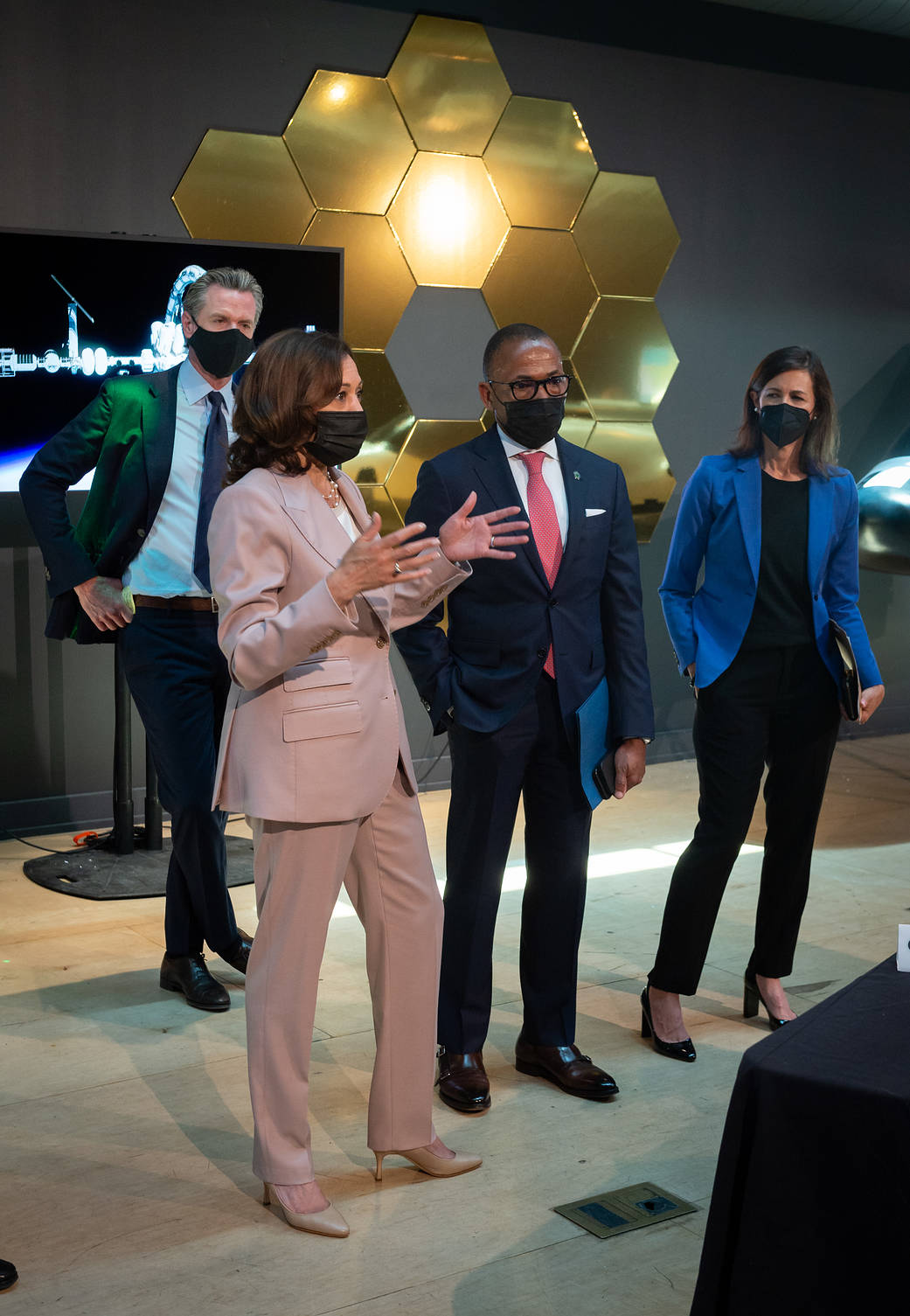
Throughout the year, Ames welcomed government, military, and civilian leaders to tour advanced testing facilities and learn more about Ames.
U.S. Special Presidential Envoy for Climate John Kerry toured Ames in March, where he visited the largest wind tunnel in the world.
In May, U.S. Congresswomen Anna G. Eshoo and Zoe Lofgren joined Ames Center Director Eugene Tu, Javier González, head of External Affairs in California at Google on behalf of Planetary Ventures, and Alex Saleh, director of project management at CBRE Group Inc., to mark the start of a new beginning for Hangar One. Through a lease agreement with NASA, Planetary Ventures has begun work to restore and preserve the historic landmark.
In September, NASA Associate Administrator Bob Cabana toured the Center and piloted a lunar lander at the Vertical Motion Simulator facility.
In August, Vice President Kamala Harris, California Governor Gavin Newsom, and Oakland Mayor Libby Schaff joined Center Director Tu and Ames Earth Science Division Chief Florian Schwandner at Chabot Space and Science Center in Oakland, California, home to the official NASA Ames Visitor Center.
U.S. Navy Rear Admiral Anne M. Swap, director of the National Capital Region Market, Defense Health Agency toured the Ames Biosciences Collaborative Facility and Arc Jet Complex in August.
First Science Instrument for NASA's Upcoming Moon Rover Delivered
by Rachel Hoover
A science instrument that can reveal the composition of lunar soil has arrived at NASA’s Johnson Space Center in Houston in preparation for integration into NASA’s Volatiles Investigating Polar Exploration Rover (VIPER). VIPER is scheduled to be delivered to the Moon’s South Pole in late 2024 by Astrobotic’s Griffin lander as part of the Commercial Lunar Payload Services initiative.
The Near-Infrared Volatiles Spectrometer System (NIRVSS) instrument (pronounced “nervous”), features a spectrometer – a device that looks at light emitted or absorbed by materials to help identify their composition. In lunar soil, that will mean detecting which types of minerals and ices are present, if any. Scientists predict NIRVSS might detect frozen water ice, carbon dioxide, ammonia, and methane. NIRVSS also has the ability to determine the nature of any hydrogen it might encounter. On the Moon, hydrogen could belong to water molecules or to its close molecular cousin hydroxyl, or just exist as hydrogen atoms – any of which could be a useful resource to help enable long-term human exploration of the Moon and other parts of deep space. Knowing the nature of the Moon’s hydrogen also speaks to the origin of the hydrogen itself, and could provide insight into the origin and evolution of water on the Moon.
“It’s great to see NIRVSS safely made its trip to Johnson from Ames, where we’ve spent many months designing, building, and testing – it’s a great step forward, ever closer to collecting science data on the Moon,” said Tony Colaprete, VIPER project scientist and NIRVSS principal investigator at NASA’s Ames Research Center in California’s Silicon Valley, where the VIPER mission is managed. “Of the four science instruments, NIRVSS was scheduled to – and needed to – arrive first because it sits down in the belly of the rover.”
The arrival of NIRVSS is one of many early build tasks the VIPER team is crossing off their lists in preparation for the rover’s construction, which begins in early 2023. In the meantime, teams at NASA Ames, NASA’s Kennedy Space Center in Florida, and Honeybee Robotics in Altadena, California, will continue testing and checkouts of the Neutron Spectrometer System (NSS), Mass Spectrometer Observing Lunar Operations (MSolo), and The Regolith and Ice Drill for Exploration of New Terrains (TRIDENT) respectively. A team at NASA Ames will continue developing the rover flight software that will be used to interactively operate the rover and conduct science in near-real time from Earth.
Your Computer Science Skills with NASA
by Anna Heiney
Computer science is vital to space exploration and something students can learn to harness the power of at any age. Join NASA and its partners in celebrating the Hour of Code and Computer Science Education Week from Dec. 5-11 by learning more about what computer science means to NASA and how students can get involved.
The field of computer science includes coding, programming, data processing and more. From the development and use of specialized software for launch and mission operations to the reams of data generated by spacecraft and projects on the ground, computer science is an integral part of most of the agency’s work.
The NASA workforce employs computer science for a wide range of uses – anywhere computers are needed to process data or handle other complex tasks faster than humans.
One example is the calculation of a rocket’s trajectory. Phillip Hargrove, a NASA public affairs specialist, previously served as a trajectory analyst in NASA’s Launch Services Program at Kennedy Space Center in Florida. In that role, his job was to ensure rockets launched in the right direction and at the right speed to get spacecraft to the right place in space.
“For one of my missions, we actually had 830 trajectories to analyze,” Hargrove said. “You’re not going to do that with pen and paper. You’re going to tell a computer, ‘This is the time we’re going to [launch], these are all the forces, and these are all the angles,’ and let it do all that math for you.”
Spaceflight isn’t the only area where NASA relies on computer science. It’s an important element in the agency’s aeronautics work, too.
Divya Bhadoria is the deputy subproject manager, meaning the second in command, for NASA’s Advanced Air Mobility (AAM) National Campaign, which is working to bring air taxis and other emerging aviation concepts to places that are historically not served by aviation. This work involves flight tests of new vehicles and simulations, which generate valuable data for the AAM team – a “gold mine” for insights into how the vehicles operate.
“We write all our own code to develop the end-to-end simulations environment we need for our research,” said Bhadoria, who works at NASA’s Ames Research Center in Silicon Valley, California. “In other words, there is a lot of code developed to make every step of our research possible.”
Fortunately, you don’t need to get a degree in computer science or be an adult to develop your skills! Computer Science Education Week is the perfect time to check out these fun activities, challenges, and resources offered through NASA and its partners.
- Open doors to new worlds with computer science through Code.org’s Hour of Code. Create a solar system with “NASA’s Space Jam,” program intergalactic scenes with out-of-this-world characters and sounds in “Hello World: Space,” and more.
- Learn to code through Microsoft Learn modules that use NASA data, such as images of Moon rocks and lunar sample data sets like those used by NASA scientists.
- Get an up-close, virtual look at the new technology aboard NASA’s Orion spacecraft with the Callisto: Space Innovation Tour by Amazon and Lockheed Martin.
- Practice programming or test-driving a lunar rover, analyze the Martian weather, and more with Tynker’s “NASA’s Return to the Moon” Hour of Code activities for a range of skill levels.
- Use coding to solve technical problems and contribute to the Artemis missions through NASA’s App Development Challenge for middle and high school students.
- Take on real-world problems on Earth and in space through NASA’s International Space Apps Challenge, an international hackathon using NASA data held virtually and in person each October.
- Check out NASA’s computer science educational resources for fun activities to try in the classroom or at home.
If you’re interested in space and NASA, computer science is worth exploring. As Bhadoria discovered, it’s a portable skill that has given her the flexibility to work in a variety of fields, including semi-conductors, biotechnology, and even surgical robotics, before joining NASA to work in aviation.
“Every industry has a need to develop or use some type of software for their business,” Bhadoria said. “The coolest thing is that, because of this, a computer scientist can take his or her core skills and work in many different industries.”
NASA's Retired SOFIA Aircraft Finds New Home at Arizona Museum
by Alise Fisher
NASA’s now-retired Stratospheric Observatory for Infrared Astronomy (SOFIA) aircraft will find a permanent home in the Pima Air & Space Museum in Tucson, Arizona. The airplane is expected to make its final flight from NASA’s Armstrong Flight Research Center in Palmdale, California, to Tucson on Tuesday, Dec. 13.
“The SOFIA mission has a powerful potential to inspire, from its discoveries about the unknown in our universe, to the engineering achievements that broke new ground, to the international cooperation that made it all possible,” said Paul Hertz, senior advisor for the Science Mission Directorate at NASA Headquarters in Washington. “We are excited SOFIA will continue to engage a diverse new generation of scientists, engineers, and explorers.”
The SOFIA aircraft is a Boeing 747SP jetliner modified to carry a reflecting telescope. Engineering innovations enabled a large door in the fuselage to remain open while the aircraft was in flight, allowing the telescope to observe infrared light from the Moon, planets, stars, star-forming regions, and nearby galaxies. After a successful eight years of science, SOFIA completed its science program and ended operations Sept. 29, 2022.
To determine a new home for the plane after the end of the mission, NASA followed regulations for the disposition of excess government equipment. Pima, one of the world’s largest aerospace museums, is developing plans for when and how the SOFIA aircraft will eventually be on display to the public. Along with six hangars, 80 acres of outdoor display grounds, and more than 425 aircraft from around the world, Pima also has its own restoration facility where incoming aircraft like SOFIA are prepared for museum immortalization after their arrival.
At Pima, the plane will join other notable NASA aircraft, like the first Super Guppy that transported Saturn V rocket parts for the Apollo missions, and the KC-135 “Weightless Wonder V” that created low-gravity conditions by flying parabolic arcs – steep climbs and dives – to conduct science experiments and train astronauts. NASA plans to support the exhibition of the SOFIA aircraft with additional mission artifacts that speak to SOFIA’s legacy.
SOFIA was a joint project of NASA and the German Space Agency at DLR. DLR provided the telescope, scheduled aircraft maintenance, and other support for the mission. NASA’s Ames Research Center in California’s Silicon Valley managed the SOFIA program, science, and mission operations in cooperation with the Universities Space Research Association, headquartered in Columbia, Maryland, and the German SOFIA Institute at the University of Stuttgart. The aircraft was maintained and operated by NASA’s Armstrong Flight Research Center in Palmdale, California. SOFIA achieved full operational capability in 2014 and concluded its final science flight on Sept. 29, 2022.
To learn more about SOFIA, visit: https://www.nasa.gov/sofia
Winning NASA Technologies Land Spacecraft, Share Agency Innovations
by Loura Hall
NASA’s bold exploration objectives require cutting-edge technology, often in the form of new inventions created by agency personnel. NASA has recognized three new technologies for the 2022 Invention and Software of the Year awards. These technologies support the exploration of other worlds and NASA’s objective to widely share its advances.
“NASA’s world-class workforce enables us to pursue innovation to enhance America’s leadership in space and yield tangible benefits here on Earth,” said Dr. Bhavya Lal, NASA associate administrator for Technology, Policy and Strategy. “This year, we recognize teams that will improve spacecraft material, enable more precise landings as we prepare to travel to the Moon and Mars, and help share our technologies to ensure they have the greatest impact possible. I’m grateful to these teams for their inspired work and dedication.”
Studying Spacecraft Materials at a Micro Scale
For decades, doctors have used CT scans – a series of X-ray images – to locate and assess injuries inside the brain and body. More recently, NASA’s Ames Research Center in California’s Silicon Valley has utilized CT imaging for an otherworldly application: Researchers have applied this technology to study how spacecraft are structurally and materially impacted by the extreme temperatures and aerodynamic forces of atmospheric entry when preparing to touchdown on a planet’s surface.
Porous Microstructure Analysis (PuMA) – an open-source software package developed by researchers at NASA Ames – uses micro-CT imaging to assess on a miniscule scale how heat and pressure can affect the lightweight composite structures designed to protect a vehicle during entry, descent, and landing. Material behavior at the microscale is important to generate a physics-based understanding of material performance, empowering engineers to design systems with higher reliability. Looking beyond thermal protection materials, PuMA’s development team has also made significant advancements that enable PuMA to analyze a wide array of materials like parachutes, batteries, and meteorites.
PuMA is the 2022 Software of the Year winner. It was developed under the NASA Entry Systems Modeling project, which is funded by the Game Changing Development Program within NASA’s Space Technology Mission Directorate (STMD).
Making Landings Safer, More Precise
On Earth, GPS is used every day for navigating cars and planes. But in space where GPS is not available, a new laser-based technology has been developed to safely and precisely navigate astronauts to their destinations on the surfaces of other worlds. Navigation Doppler Lidar (NDL), developed with support from STMD at NASA’s Langley Research Center in Hampton, Virginia, determines a spacecraft’s exact velocity and position to softly land at the desired location on planetary surfaces. The technology uses lidar (light detection and ranging), which is a remote sensing method using lasers.
Two NDL units will fly on upcoming Commercial Lunar Payload Services lander flights. Invented at Langley, NDL is also part of the Safe & Precise Landing – Integrated Capabilities Evolution (SPLICE) project, which is led by NASA’s Johnson Space Center to develop, demonstrate, and infuse precision landing and hazard avoidance technologies for NASA and for potential commercial spaceflight missions.
NDL is the 2022 Invention of the Year in the commercial category, which recognizes a NASA technology that has been licensed and has resulted in commercial sales. NDL has been licensed to several companies, including Psionic in Hampton, Virginia. Psionic is customizing NDL for use in both terrestrial and space applications.
Sharing NASA’s Innovations
The NASA Technology Transfer System (NTTS) is an enterprise software tool developed in-house for STMD’s Technology Transfer Program, which aims to find the widest possible applications for NASA technology through partnerships and licensing agreements with industry, academia, and other U.S. governmental agencies.
NTTS contains over 60,000 technologies supporting all ten NASA field centers and Headquarters. The tool provides a comprehensive suite of data systems, web-enabled applications, and infrastructure for both NASA personnel and external users from private companies, academia, and other federal, state, and local government agencies to request technology licenses from NASA. It facilitates and streamlines the entire technology transfer process, including the reporting of new technologies, protecting intellectual property, and commercializing technologies through various technology licenses, software releases, spinoffs, partnerships, and success stories.
NTTS is the 2022 Invention of the Year winner in the government category. NTTS has enabled NASA to execute more technology license agreements than ever before, breaking the agency’s annual record with 211 licenses executed in 2021. More licenses mean more opportunities for commercial products or services to be created in the forms of spinoffs that help protect the planet, create jobs, boost the economy, and even save lives NTTS has been transferred via software usage agreements to 11 U.S. federal agencies.
About NASA’s Invention and Software of the Year Awards
NASA’s Invention of the Year and Software of the Year awards recognize the best innovations developed by various teams across NASA. The Inventions and Contributions Board evaluates the nominations (for the software award a panel of software experts provide the Board with input), and winners are selected and recommended to the Administrator for approval.
The Invention of the Year awards are sponsored by NASA’s Office of the General Counsel. The Software of the Year award is sponsored by offices of the Chief Engineer, Safety and Mission Assurance, and Chief Information Officer. The Inventions and Contributions Board is managed by NASA’s Office of the General Counsel with support from the agency’s Office of Technology, Policy, and Strategy.
BioNutrients – A Biology Experiment That Tests the Way to Use Microorganisms
by Abigail Tabor
A biology experiment called BioNutrients is testing a way to use microorganisms to produce nutrients – off Earth and on demand – that will be critical for human health in space.
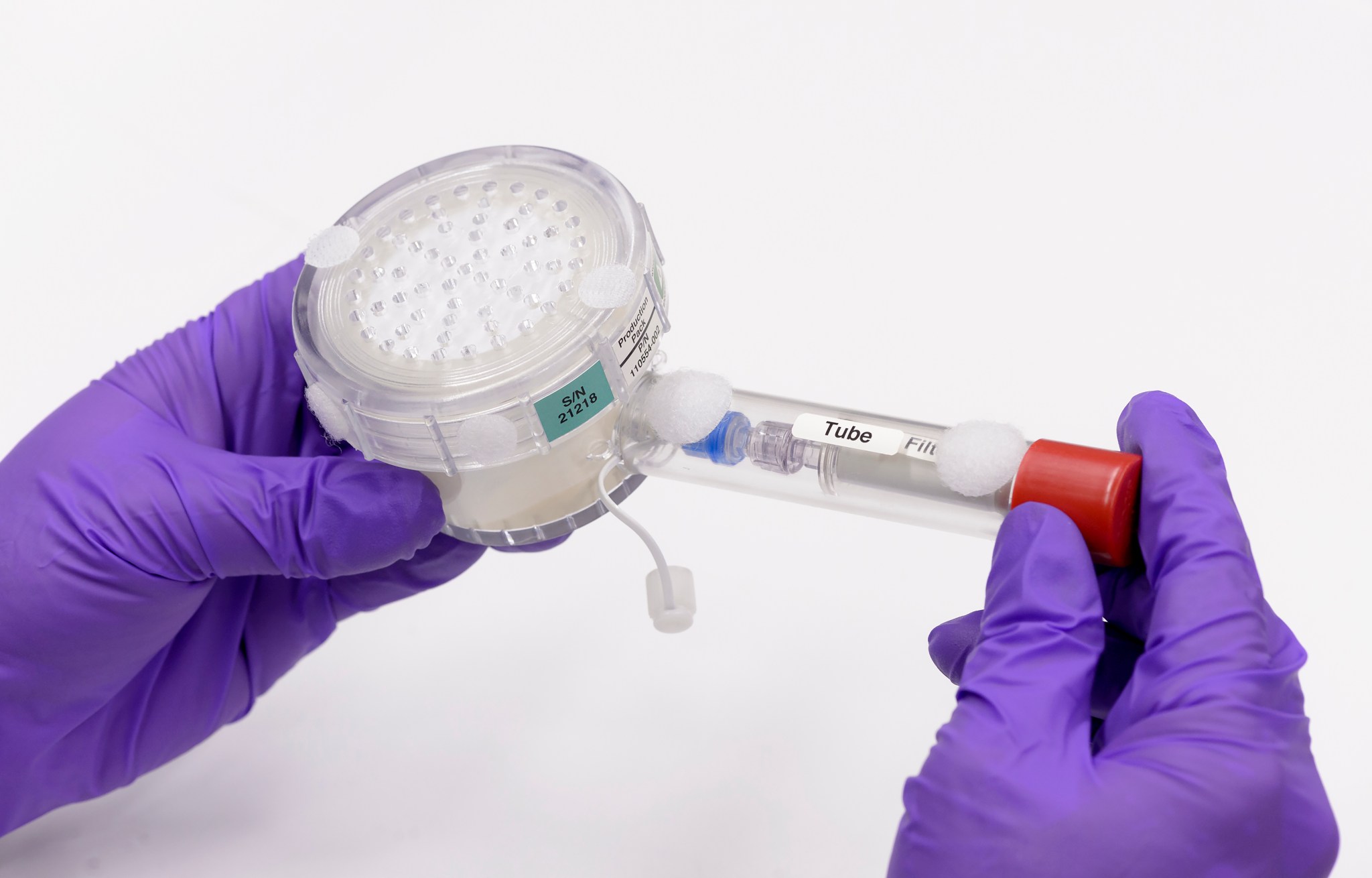
Sailors might have avoided scurvy if NASA had been around in the age of exploration on the high seas. The condition is caused by a vitamin C deficiency, and many people died from spending months at sea without fresh fruits and vegetables. In the age of exploration into deep space, astronauts, too, will need a way to get the right nutrition. Planning ways to supply food for a multi-year mission on the Moon or Mars may require making food and nutrients in space. NASA scientists are testing an early version of a potential solution: get microorganisms to produce vital nutrients so that, whenever they’re needed, astronauts can drink them down. The same kind of system designed for space could also help provide nutrition for people in remote areas of our planet.
Microbial Nutrient Factories
With an experiment called BioNutrients-1, astronauts aboard the International Space Station will help test a new system over the course of five years. It was developed by scientists at NASA’s Ames Research Center, in California’s Silicon Valley, using this strategy: take a safe organism already present in our food (in this case, baker’s yeast), modify it so that it produces an essential nutrient, and build the right hardware to let astronauts grow the yeast in space. Like tiny living factories, the microorganisms will go about making the desired product. The nutrients that the yeast will produce in this experiment are called beta carotene and zeaxanthin. These are antioxidants usually found in vegetables, and they’re critical for keeping our eyes healthy.
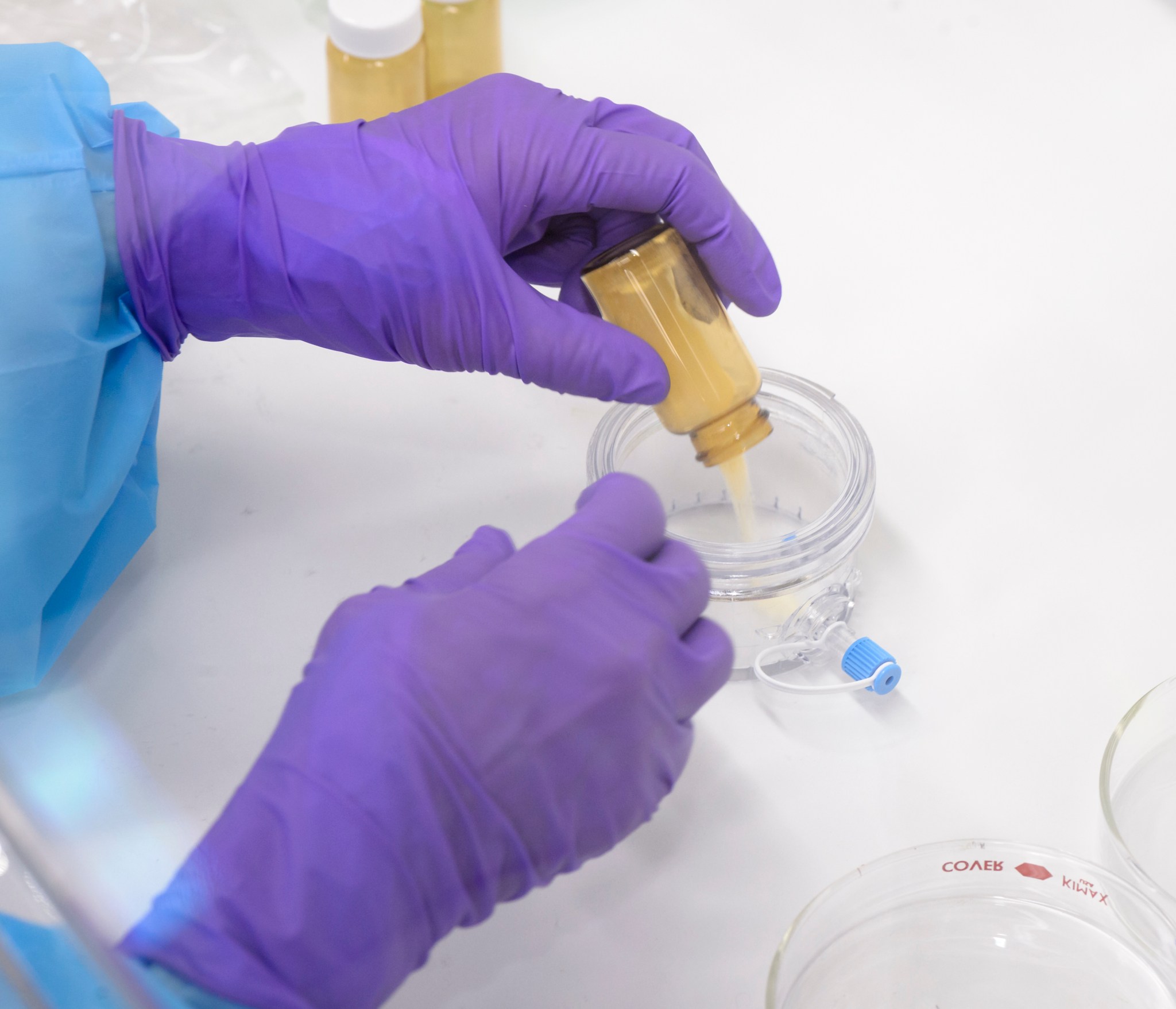
Although astronauts on the space station will not consume anything for the BioNutrients-1 experiment, they will conduct multiple rounds of tests on the system. For each test, they’ll add sterile water to a mixture of dehydrated yeast and its powdered food source, mix well and keep the packet warm for 48 hours. Then, they’ll freeze it to be analyzed later, back on Earth. NASA scientists will check how the system performed, including how much yeast grew in the packets and how much nutrient the experiment produced.
Essential (Nutrients) for Exploration
An on-demand nutrient production system like this will be vital for human exploration, because it may not be possible to provide complete nutrition from stored foods during a multi-year mission. What’s more, even with a supply of nutritional supplements, many nutrients have a limited shelf life. Some things, like vitamins, also just work better in their fresh form than in a processed tablet.
The BioNutrients-1 system will test two types of yeast with different “lifestyles” in the nutrient-production packets. One makes spores, a dormant form of the organism, as part of its lifecycle. The yeast should stay stable in this form for five years, giving it a reasonable expiration date for use during long-term missions on the Moon or to the surface of Mars. The other type does not make spores, and so may have a shorter shelf life. However, this type is interesting for other reasons. People are already eating this same yeast in probiotic supplements on the market today. And there are many more yeast species of this type available to scientists for potential use in future nutrient production systems, so understanding how they work could be important for the research.
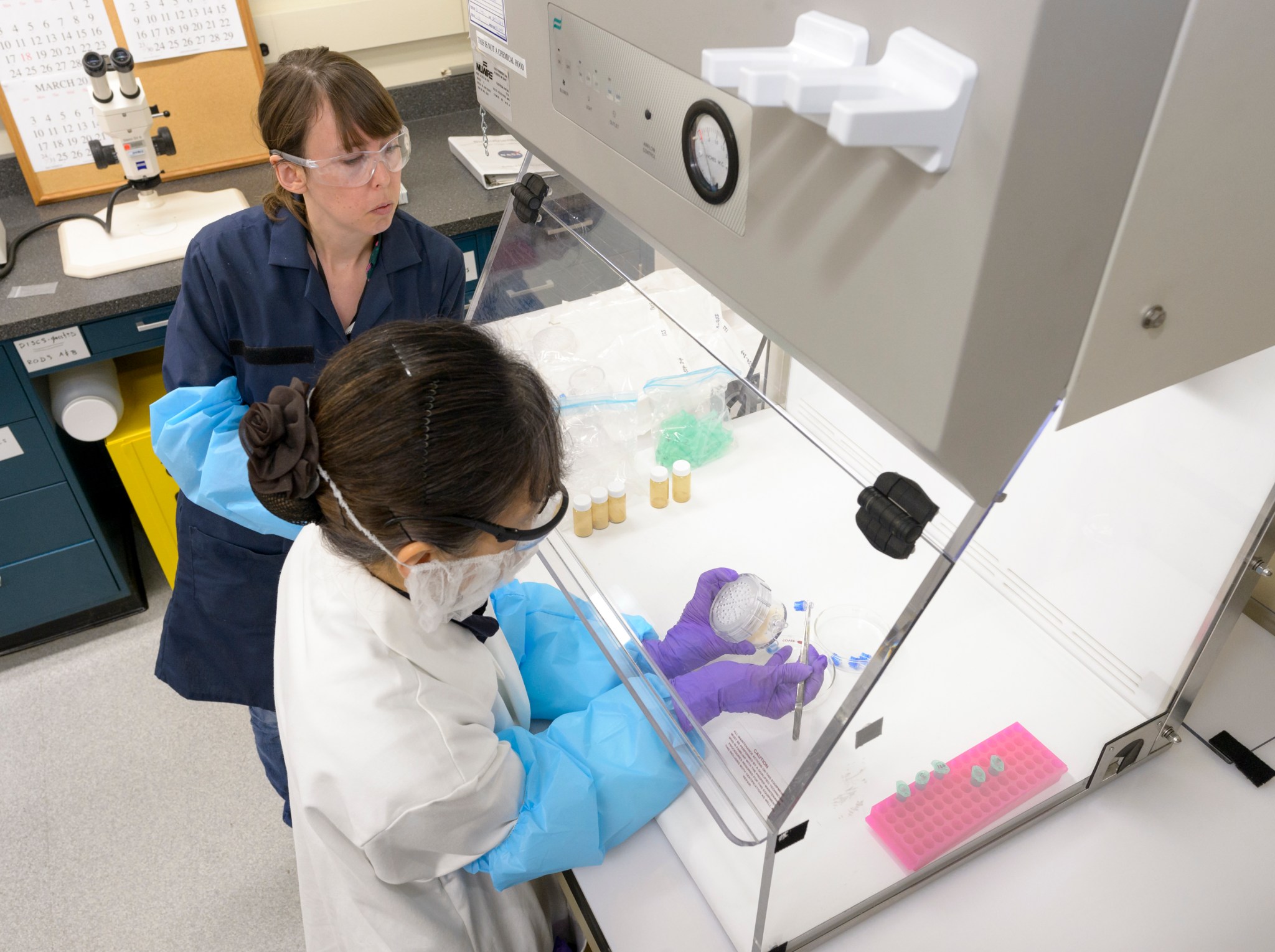
Space station crew members will perform tests on both yeast types periodically over the course of this initial experiment. This will allow scientists to check how long their specially engineered yeast stays good on the shelf and able to churn out fresh nutrients that humans will need to stay healthy in space.
As an additional part of the BioNutrients-1 investigation, the researchers are studying the “shelf life” of other types of microbes — different from the two types of yeast tested in the production packets — to track how well the various organisms function during the five-year span in space, and what genetic features allow them to survive for the long haul. Samples of these specially prepared biomanufacturing and probiotic microorganisms are stored on the station and periodically returned to Earth for analysis.
BioNutrients-2
The BioNutrients-2 investigation launched to the space station aboard SpaceX’s CRS-26 mission on Nov. 26, 2022. This phase of the study builds on early results from BioNutrients-1 and incorporates several new features. The overall goal is to test an on-demand system to produce specific amounts of key nutrients using minimal equipment.
BioNutrients-2 broadens the types of microorganism being tested. It uses the same two yeast strains used in BioNutrients-1 and adds four new types. This includes two microorganisms that produce yogurt, one that produces a fermented milk product known as kefir, and another type of yeast specially prepared to produce follistatin, a protein linked to maintaining muscle mass.
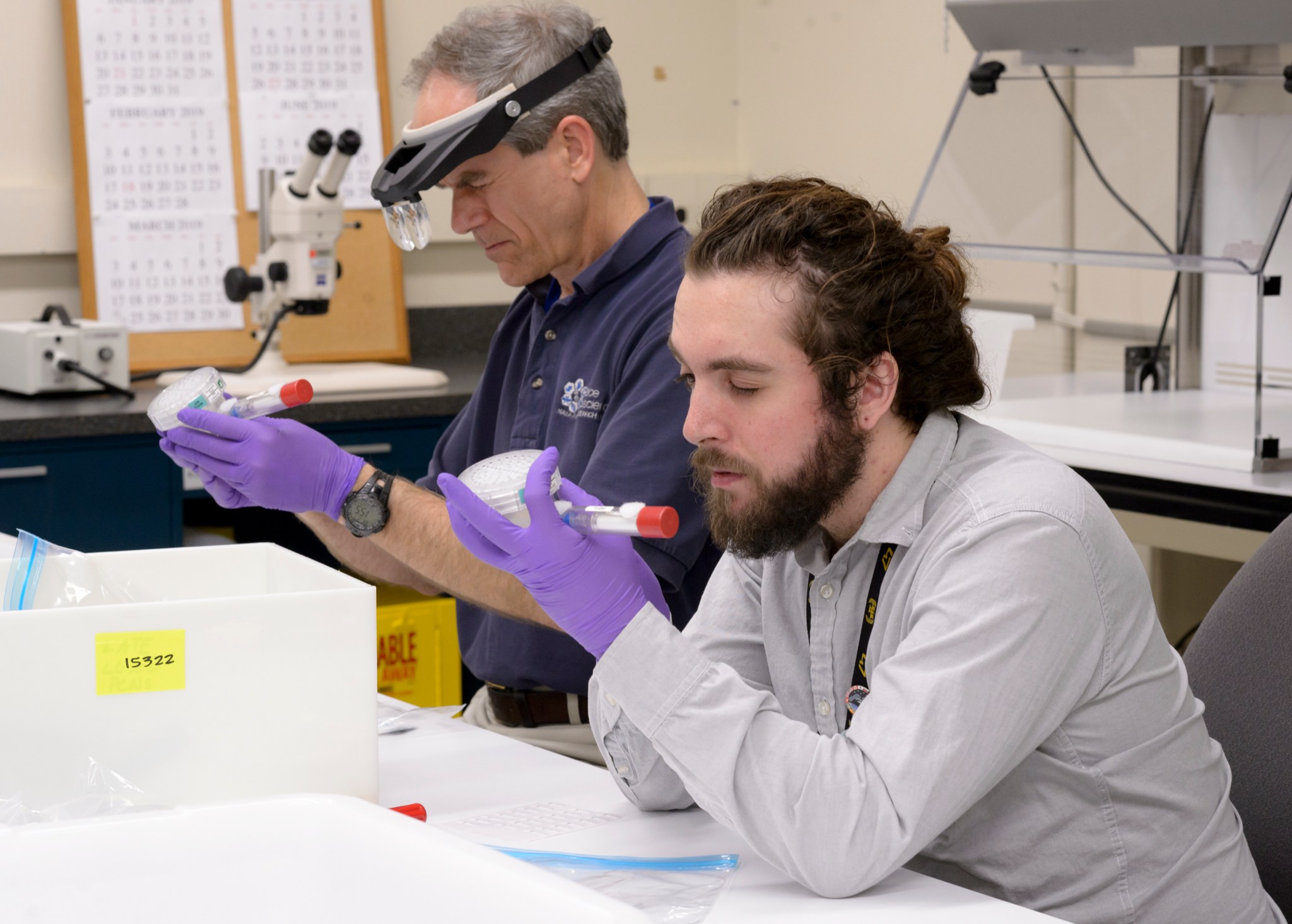
The entire range of microorganism types will be tested in a BioNutrients-2’s new hardware. The system uses lightweight, flexible bags – a form factor comparable to existing crew food products – rather than the rigid containers being tested for BioNutrients-1. This change reduces the mass and the volume of the system, offering advantages for long duration spaceflight when volume and mass are limited.
Two experiment runs are planned for each sample type: the first at approximately 30-60 days after launch, and the second at about six months. Each run involves a crew member retrieving four bags of a given sample type, adding water, and agitating the bags to mix the contents. The crew will place the bags in an incubator to promote growth. At the end of the run, the crew will remove the bags from the incubator and freeze them. The bags will be returned to Earth, still frozen, for analysis.
Making Molecules and Medicines in Remote Places
This technology NASA is developing for future astronauts could also be used by people living in remote areas on Earth today. Results from the study will tell NASA scientists a lot about how to produce other molecules that will be critical for human health in space, including medicines for treating various ailments. Promising research is under way now to use microbes in a range of space applications. By developing microorganisms that can withstand long periods of inactivity and be revived successfully, BioNutrients is also taking steps toward making that future a reality.
Milestones:
- April 2019 – The BioNutrients-1 experiment launched to the International Space Station aboard Northrop Grumman’s 11th commercial resupply services mission
- June 2019 – An experiment run of the BioNutrients-1 packs in space completed by Canadian Space Agency astronaut David Saint-Jacques.
- June 2019 – BioNutrients-1 samples returned to Earth aboard SpaceX’s 17th commercial resupply services mission.
- August 2019 – BioNutrients-1 samples returned to Earth aboard SpaceX’s 18th commercial resupply services mission.
- January 2020 – BioNutrients-1 samples returned to Earth aboard SpaceX’s 19th commercial resupply services mission.
- January 2020 – An experiment run of the BioNutrients-1 packs in space completed by NASA astronaut Andrew Morgan.
- April 2020 – BioNutrients-1 samples returned to Earth aboard SpaceX’s 20th commercial resupply services mission.
- January 2021 – BioNutrients-1 samples returned to Earth aboard SpaceX’s 21st commercial resupply services mission.
- January 2021 – An experiment run of the BioNutrients-1 packs in space completed by NASA astronaut Shannon Walker.
- July 2021 – BioNutrients-1 samples returned to Earth aboard SpaceX’s 22nd commercial resupply services mission.
- January 2022 – BioNutrients-1 samples returned to Earth aboard SpaceX’s 24th commercial resupply services mission.
- February 2022 – An experiment run of the BioNutrients-1 packs in space completed by NASA astronaut Thomas Marshburn.
- August 2022 – BioNutrients-1 samples returned to Earth aboard SpaceX’s 25th commercial resupply services mission.
- November 2022 – The BioNutrients-2 experiment launched to the station aboard SpaceX’s 26th commercial resupply services mission
Partners:
BioNutrients was developed by Ames. The Game Changing Development program within NASA’s Space Technology Mission Directorate manages the project, which is part of a larger synthetic biology portfolio. Additional support is provided by Exploration Systems Development Mission Directorate as part of Exploration Capabilities. The project was previously funded by NASA’s Advanced Exploration Systems program within the Human Exploration Operations Mission Directorate.



























